Feed aggregator
Women in SF&F Month: Pat Murphy
Today’s Women in SF&F Month guest is Pat Murphy! Her work includes the short stories in Women Up to No Good, the Philip K. Dick Award–winning collection Points of Departure, and the Nebula Award–winning novel The Falling Woman. Pat’s latest SF&F novel—her first in more than 20 years—is The Adventures of Mary Darling. This subversive retelling of Peter Pan and Sherlock Holmes focuses on Mary Darling—the mother of the children who flew away with Peter Pan and the niece of […]
The post Women in SF&F Month: Pat Murphy first appeared on Fantasy Cafe.The Inheritance: Chapter 2

A massive cavern spread in front of us, awash in bioluminescence like some bizarre rave. It resembled an enormous egg set on its side, with the wider end to the right ending in a solid wall and the narrow end to the left splitting off into several dark passages. The cavern’s floor sloped to the center where a wide stream ran through the cave from left to right. The water was like glass, perfectly clear.
At the banks, the stream branched into several small pools bordered by rimstone dams, some shallow, others deeper. The pools flowed into each other, stretching toward a flat island on our right. The stream split around it and emptied into a lake, its waters moving slowly and disappearing under a spectacular flowstone wall where layers of calcite formed a frozen stone waterfall.
“I need lights, people!” Melissa called out.
The mining crew spread out, planting floodlights along the nearest wall. The portable generator on the central cart sputtered into life, and bright electric light illuminated the cavern. The sloping floor was ridged with calcite, and it looked slick. A good way to break a leg.
“Much better,” Melissa declared. “It’s almost like we know what we’re doing.”
London nodded to the tank. Aaron moved to the left and planted himself in the narrower part of the cave, between the dark tunnels and the mining crew. London stayed at the entrance, guarding our exit route. The three strikers fanned out along the perimeter.
It was my turn to shine. The cavern walls were awash with swirls of bright green mixed with rust-colored metallic deposits. Promising.
I took a deep breath and flexed.
The official term was talent activation, but to me it felt like flexing a muscle I didn’t normally use. The world turned crystal clear. The edges of the rimstone dams and contours of the flowstone waterfall came into sharp focus, as if I’d adjusted my eyes to higher resolution. The outlines of individual mineral deposits glowed slightly.
I focused on the closest wall, scanning and evaluating, sorting through different hues. Malachite, copper-rich chalcopyrite, decent but not exciting. Cuprite, quartz, calcite, trash, garbage, junk…
A patch of funky plants to the left glowed with dull, pale yellow. Healer Slipper. A weird variant, but definitely in the same ballpark as the more common varieties. If processed, it would yield a potent broad-spectrum antibiotic. A decent haul, if nothing else showed up.
In the wake of the gate catastrophe and the emergence of the Talents, humanity had tried to find some frame of reference. We settled on video games. A lot of the Talent classification mirrored the familiar game classes: tanks, healers, scouts, and so on. The closest video game match for my talent would’ve been appraiser, but the government nixed that one because it didn’t sound heroic enough and was too “materialistic,” which was utterly hilarious considering what I did. Unlike Melissa, who only sensed ores and only when she was on top of them, I evaluated everything in my environment, organic or inorganic.
So far, the cavern has been relatively disappointing. Usually, orange gates offered a little more. I pivoted slightly, turning away from the wall.
The inside of the stream lit up like a Christmas tree. Well, that was something.
“Gold in the water,” I announced. “Check the pools.”
“Go!” Melissa barked.
The miners scrambled over calcite walls. The pools directly in front of them ran a little deeper, and the water came up to their thighs.
Sanders thrust his hand into the pool and pulled up a tangerine-sized gold nugget. “Holy shit!”
The mining crew erupted into a controlled frenzy. Half of the miners went into the pools with buckets, while the other half positioned themselves on the shore, emptying the buckets into wheelbarrows.
I kept scanning. Gold was okay. Just okay.
“We got time, people,” Melissa called out. “Don’t hurt yourself. Slow is smooth, and smooth is fast.”
A bright swath of deep crimson flared on the edge of my vision. The colors of the glow didn’t always make sense, but red usually meant something valuable. I turned slowly, following it, and focused. A thick vein running from the center of the cavern all the way to the far wall…
It couldn’t be. I squinted at it to make sure I wasn’t imagining it.
No, it was there. And the crimson got deeper at the other end of the cavern.
“Melissa?”
“Yes?”
“Dump the gold.”
The mining crew stopped. Sanders closed his fists around a handful of nuggets and hugged them to his chest. Gold fever was a real thing. Something about the bright shiny yellow metal made people lose their minds.
I pointed to the beginning of the vein along the wall of the island, by the two pools closest to the shore. “Adamantite. From here to there. Solid, less than a foot down. We’ll need more carts.”
Melissa splashed into the stream to the adamantite vein buried under calcite deposits and put her bare hands onto the stone. She grunted, squeezed the rock surface with her fingers, shook from the strain, and stumbled back.
“Goddamn! Team One here! Team Two there! I want those drills running five minutes ago!”
The gold went flying. The mining crew grabbed their drills. Safety glasses and noise-dampening headphones went on, and they waded into the river and attacked the dams and the island.
Gold was expensive but adamantite was twelve times more valuable, because it could be refined into adamant. In the same family as osmium, adamant was incredibly durable. Adamant-enhanced armor could withstand machine gun fire. Adamant-coated blades cut through solid metal and monster bones like butter, without losing their edge.
We found it rarely and usually in small deposits. A cubic yard of adamantite was a record-breaking haul that would mean a big bonus for every guild member that entered this breach. We had a lot more than a cubic yard here. In all of my time crawling in and out of the breaches, I had never found a vein half that large.
The drills chiseled at the rock with a dull roar. The first chunk of adamantite fell free, a dark, almost black basketball-sized rock that looked like frozen tar in the crystal-clear stream. The drills stopped as everyone stared at it. Melissa tried to lift it out of the water, couldn’t – it was ridiculously heavy – and laughed.
“We’re gunna be rich!” someone yelled.
“Ada, I love you!” Melissa declared. “Marry me!”
“Sorry, I don’t want to ruin such a good friendship.”
People laughed. Next to me, London cracked a smile.
“Friendzoned,” Melissa groaned.
“It’s not you, it’s me, Mel. I’m the problem.”
More laughter.
Melissa shook her head. “Back to work, people! And someone help me with this rock.”
The miners resumed their drilling.
The vein continued under the stream, veering across the cavern floor to the left and behind the far wall. Getting adamantite from under the water would be cumbersome, and our time was short. The wall deposit lay deeper, but it was a better bet.
I went down the slope to the water. The best place to cross was to the left, by Aaron, where the stream was relatively shallow. I headed there and waded in, careful where I put my feet. The rocks were damn slippery, and the water came up past my knee. Magnaprene wasn’t the most comfortable fabric, but it was waterproof.
I hiked over the shallow calcite ridges to the wall, pulled a can of fluorescent paint from the pocket of my coveralls, and set about tracing the contours of the deposit in bright Safety Yellow. A hell of a find. Not that I would get anything out of it other than bragging rights. Government employees didn’t get gate loot bonuses, and that wasn’t why I’d taken this job.
The steady roar of the drills filled the cavern.
I was thirty-three years old when I saw my first glow. One of the larger US guilds somehow obtained permission to sell sebrian knives to the public. Sebrian was found only in breaches, and the knife prices started at $1,000 for a tiny pocket blade. Our advertising agency had taken the contract and promptly sent it to me with the key phrase of “rugged luxury.”
I was sitting in my office staring at the knife and trying to figure out the right approach, when the blade turned pale pink. The glow refused to fade, and when I focused on it, something in my brain clicked. The weight, the density, the structure of the metal somehow popped into my mind and combined into a specific … profile was the best word.
I drove to the ER. I thought I was dying. Twenty-four hours later the DDC came calling with a contract and a patriotic sales pitch. Assessors like me were rare, and the government hoarded us, to the point of making it illegal for guilds to hire their own private assessors. The guilds had poured an obscene amount of money into lobbying against that law but got nowhere.
The invasion wrecked my life. I’d looked at that contract and realized I could do something about it. Every time I went into the breach, I found something to make us safer. Today it was adamantite. A drop in the bucket, but it was my drop.
I finished tracing the wall and set the can on a rock.
Elena crossed the stream and lingered on my left, looking toward the tunnels. She peered at the dark passageways, turned, her face sour, and called, “Stella!”
Stella, who was on the other shore watching the miners, didn’t move.
“STELLA!” Elena roared.
The dog handler spun around.
The scout waved her over. “Bring the dog!”
Stella splashed through the stream, Bear on a leash, and trekked over the ridges to us.
“I need you to check the tunnels!” Elena yelled over the drilling noise.
“Which tunnel?”
“Start with the left!”
Bear yanked at her leash, jerking Stella backward, toward the stream. Stella said some command I didn’t catch.
Bear yanked on the leash and erupted into barks.
Elena waved her arms. “Control your dog –”
Something burst out of the middle tunnel. It swept past Aaron, a vaguely humanoid shape in pale blue garments, so fast it was a blur. Four other blurs chased it, wrapped in dark gray. They tore past the tank in a flash.
Aaron’s top half – shield, armor, and body – slid to the side and fell to the ground.
For a horrifying moment, I stared straight at the stump of his torso, still standing upright. It was standing upright.
The blurs wrapped around us. I froze. They spun about me like a whirlwind, the four gray beings striking and slicing, while the creature in blue parried with impossible speed. I caught a glimpse of arms in dark armor gripping silver blades and inhuman faces with fangs bared. A second, and they tore across the cavern toward the wall and the mining crew.
Untouched. I was somehow uninjured.
I turned to Stella on my right.
Her head was missing. There was her torso in indigo magnaprene, her neck, but no head.
The headless body crumpled to the ground.
A gasp came from the side. I turned on autopilot, still trying to process Stella’s missing head. Elena’s guts spilled out of her stomach. The scout clutched at herself. Dark blood poured out of her mouth. She made a horrible gurgling noise and fell.
This couldn’t be happening. It was a weird, horrible nightmare. I was dreaming that I found the magic motherlode of adamantite and then monsters came and killed everyone.
The air smelled like blood and bile. To the left four inhuman creatures tore at their prey in the blue robe, running on the walls and leaping in for the kill only to be knocked aside. Three miners floated in the stream, face down and the water was red, so red…
Oh God. It’s real. It’s all real.
Panic smashed into me like an icy hammer. I had to get out of here. Now.
The only safe exit was on the other side of the stream. I sprinted across the ridges to the water.
To the left, the fight swung back and forth along the lake’s shore.
I slid over the first rimstone damn, tore through the pool, climbed over the other side, and landed into the stream. Water came up to my thighs and I waded through it, squeezing every drop of speed out of my body.
Half of the mining crew was still drilling.
“Run!” I screamed, waving my arms. “Run!”
Sanders turned, plucking the headphones off his left ear, saw my face, whipped around, saw the creatures, hurled the drill aside, howled, and ran for the entrance. The line of miners broke as people charged to the exit.
Time stretched like molasses. There was only me and the water trying to stop me. I just had to make it across the stream.
At the cave entrance, Melissa was scrambling up the slope, toward London. The blade warden stared straight at me. Our gazes met.
Help me…
A door slammed shut in London’s eyes.
No. No!
Melissa shoved Anja Presa out of her way. The slender woman slid on the rocks and fell, rolling down to the stream.
I can’t die here. I have to get home to my kids!
I was running so fast. Faster than I’d ever run in my life, and I wasted precious breath on a scream. “Wait! Wait for me!”
London’s face was cold like ice. He yanked something off his belt. A grenade. He carried aetherium concussive grenades to be used as a last resort.
“Throw it!” Melissa howled and ran past him.
London looked straight at me.
Alex! No!
He dropped the grenade. It rolled toward the stream, bouncing over the limestone. The blue forcefield of his warden talent flared into life, wrapping around London. He turned and fled into the tunnel.
The world exploded.
The blast slammed into Sanders ten yards ahead of me. Water punched me off my feet. I flew like a rag doll and smashed against solid rock. My right leg snapped like a toothpick. My spine crunched. Agony splashed across my side and bit into my ribs. My ears rang, my head swam, and the air in my lungs turned to fire.
I tried to breathe and couldn’t. There was water on my face. I was in the stream face down. I had to get upright, or I would drown.
I wrenched myself up.
Bright white aetherium smoke filled the cave. I couldn’t see anything, I couldn’t hear anything, I couldn’t breathe. I could only hold still as the pain drowned me.
“Mom! Don’t die!”
I won’t. I promise.
I forced myself to take a tiny breath. It felt like jagged glass cutting its way through my throat. I coughed through it and willed myself to take another. And another, swimming through the pain, one tiny sip of air at a time.
The smoke drifted up. My vision cleared. I was sitting in one of the pools by the shore, with the water up to my armpits, with my back pressed against the rimstone wall. Next to me a severed human head rested on the pool’s bottom. The dark curly hair swirled with the current. Stella.
It should’ve hit me like a semi, but instead I simply noted it, the same way I noted the blood spreading from my right leg and the broken glass that ground in my lungs with every breath.
I pulled the leg of my coveralls up, out of the boot. A jagged bone cut through the skin of my calf. A compound fracture. Okay. I tugged my pant leg over it.
I had to get the hell out of here. Out of this cavern. Out of the breach.
The exit was no more, blocked by a wall of rubble. London’s grenade collapsed the ceiling of the tunnel. He and Melissa left me to die.
The clump of alien creatures passed along the opposite wall, all but floating over the debris that had sealed the exit. I didn’t hear any gunfire. Our escorts were dead.
The aliens darted to the right, absorbed in their fight. They weren’t targeting the humans. Aaron, Stella, Elena, they were simply in the way, cut down in passing as the four creatures in gray tried to kill the being in blue. And if their fight swung this way, I would be in the way, too.
I had to get out of the line of fire.
The wall in front of me, where the exit used to be, was at least forty yards away and sheer.
I looked over my shoulder. There was a niche in the wall behind me, next to my yellow paint marks, natural depression in the rock. A place to hide.
I turned around. My right leg screamed. Standing was a no go. I would have to crawl on all fours.
I clenched my teeth and crawled out of the pool.
My right leg burned, sending stabs of hot pain through my knee. I could do it. Stay low, move slowly, don’t present a threat. It was only pain. I could endure pain.
Twenty yards to the wall.
Fifteen.
I hit my knee against a sharp rock, and my weight landed on my injured leg. The world went white for a second. I sucked in a small breath and kept moving.
Ten yards. Almost there.
Almost.
My fingers touched the stone. I turned around and tucked myself into the niche, pressing my back against the wall. There was a trail of my blood across the cave floor.
The creature in blue was still moving, but only two gray blurs remained. The third lay on the rocks, a smudge of dark fabric that shifted whenever the fight drew closer, stretching toward it like a living thing. I couldn’t see the fourth.
To the right something moved by the rock.
I sat very still.
A furry head with big ears poked out from behind an outcropping.
Bear.
I licked my lips, trying to get my mouth to work. “Bear.” I could only manage a whisper. “Come.”
The German Shepherd crawled toward me, pressed against my thigh, and let out a soft whine.
“They left you, too.”
I hugged the dog to me. We sat by the wall and watched the fight tear across the cave. The blurs were so fast. How could anyone move that quickly? It should’ve been biologically impossible.
One of the remaining gray blurs collapsed.
The last gray attacker shot toward us. It took me half a second to realize it wasn’t a coincidence. It was aiming for me.
There was no time to run, no time to do anything. I threw my arm in front of Bear shielding her on pure instinct. The gray blur loomed above us… and stopped.
I finally saw it clearly, a tall creature with four arms, wrapped in a tattered gray cloak. Its hands had too many fingers, long and clawed, and each hand clenched a sword. It stared at me with terrifying eyes, its irises missing, its sclera a solid mass of solid black, and its mouth, on the face of white pearlescent skin, was a wide, dark slash filled with nightmarish teeth. A blue blade protruded from its chest.
This is also real.
The gray cloak stretched toward my face, like some strange amoeba, its strands long and viscous.
The blue blade turned, twisting.
The creature spat purple blood and went limp.
The sword slid back into its body. The cloaked being fell to the side and slid a few feet down the slope.
A tall figure stood behind it, clad in a shimmering, ice-blue robe. The silhouette looked chillingly human, too tall, with limbs that were too long, but unmistakably familiar. The head was a solid chunk of metal, twisted into a sleek horned shape. The same metal, blue with gold filigree, sheathed their body under the robe. No visible skin. Even the fingers of their right hand, gripping the blue sword, were coated in metal. Their left arm was missing, cut off just below the biceps, and bright red blood spurted from the cut.
None of my briefings had ever mentioned a being that appeared this human. Animals, monsters, inhuman sentients with strange anatomy, vaguely humanoid beings, yes. But never this.
The figure touched their helmet. It split apart and retracted into itself. An older woman looked at me. Her skin was a muted pastel pink in the center of the face, darkening to a vivid turquoise near the hairline. A straight nose with a blunt tip, a narrow-lipped mouth with the same pink lips, and upturned eyes with blue-green irises, slightly too large for an Earth native, but not enough to alarm anyone.
Aside from the skin color, she looked so human, it was terrifying. There were crow’s feet at the corners of her eyes and laugh lines by her mouth. Either the DDC did not know, or they’d lied.
The woman stared at me. Her eyes were sad and mournful.
I stared back.
She swayed and fell.
What do I do now?
The sound of hoarse breathing echoed through the cavern.
She saved me. If she hadn’t stabbed the gray attacker, I would be dead.
Another hoarse breath. Another.
Fuck it.
I shifted on all fours and crawled the few feet to the woman.
The arm was sheared as if by a razor blade, the cut so precise, it was like an anatomy slide. I could see the bones among the bloody muscle. Blood shot out with every breath.
“We’ll need a tourniquet. Hold on.”
I dug in the pocket of my coveralls, extracted the paracord I always carried, and pulled it loose. Paracord was a shitty way to make a tourniquet, but she was bleeding out and I had nothing else. I folded the paracord length wise until I had about three-foot stretch of cord, wrapped it around what was left of her arm, and pulled it into a knot. The blood was still spurting.
I patted myself. I needed… Here. I pulled a slim flashlight out of my pocket. I always brought one as a backup to the light in my hard hat. I pressed the flashlight into the knot and tied another knot over it.
“This will hurt, and you’ll lose what’s left of the arm. I’m sorry. We have to stop the bleeding.”
I twisted the flashlight, tightening the knot. Once, twice, three times.
The woman reached out with her right arm and touched my hand. Her fingers were cool, their touch feather-light.
“I’m sorry,” I told her.
The blood stopped spurting. Now I just had to secure this…
The woman touched her own forehead. Her fingers dipped into the skin, sinking into a seemingly solid skull.
It had to be a hallucination. I was losing it from blood loss and pain.
The woman pulled something out of her head. It was round and glowing, like a brilliant jewel lit from within. It was so beautiful. The colors swirled and danced, a stunning, mesmerizing gemfire.
I had to look away, move, run, do something, but I had no will to move. The gemstone was too beautiful to resist. It was coming toward me, held in the woman’s long fingers. Closer. Closer.
The gem touched my forehead.
The Universe unfurled with light and color. A distant voice whispered inside my head.
“Treasure your inheritance, my kind daughter.”
Everything went dark.
The post The Inheritance: Chapter 2 first appeared on ILONA ANDREWS.
Spotlight on “My Name is Emilia del Valle” by Isabel Allende
In the spellbinding historical novel My Name is Emilia del Valle, a young writer journeys…
The post Spotlight on “My Name is Emilia del Valle” by Isabel Allende appeared first on LitStack.
Monday Meows
Da fuck?
I was born for this moment. Come at me, poultry demons!
Cluck, cluck, cluck, *******Fucker!
I’ll be under the blankets, thankyouverymuch.
Same but breathable. Some of us need oxygen for our brains.
Are you calling me stupid?!
The fact that you have to ask…
Send the chickens to me. I need blood and souls for Bast.
A (Black) Gat in the Hand: William Patrick Murray – Who was N.V. Romero?
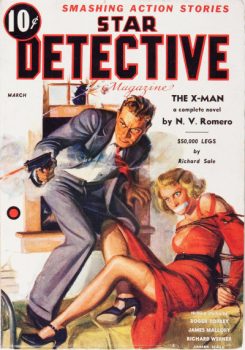 “You’re the second guy I’ve met within hours who seems to think a gat in the hand means a world by the tail.” – Phillip Marlowe in Raymond Chandler’s The Big Sleep
“You’re the second guy I’ve met within hours who seems to think a gat in the hand means a world by the tail.” – Phillip Marlowe in Raymond Chandler’s The Big Sleep
(Gat — Prohibition Era term for a gun. Shortened version of Gatling Gun)
Will Murray has graced this column multiple times, and he has delved into a mystery or two. He’s got another one today, looking into a Pulp byline from the nineteen thirties that has gnawed away at him. And by golly, Will finally had enough! Read on…
____________________________________________
For literally decades, I’ve been intrigued and baffled by the cryptic byline N. V. Romero, which was emblazoned on the front cover of the March, 1937 Star Detective Magazine.
I don’t remember where or when I picked up that old Red Circle pulp magazine. Probably at a collector’s convention somewhere in the 1970s or 80s. It grabbed my attention because the cover-featured lead novel bore the intriguing title,
“The X-Man.”
That’s a coinage I did not think existed prior to Marvel Comics releasing X-Men #1 in 1963. So I grabbed it. I probably paid about five bucks. It was in reasonably good condition. And it was published by Martin Goodman, who later launched Marvel Comics.
This issue is comparatively rare. My copy has the distinction of having been photographed so the cover could appear in Les Daniels’ 1990 book, Marvel, as a weird precursor to The X-Men.
The story Stan Lee always told was that he wanted to call his new comic book about a school for teenaged superheroes, The Mutants. Publisher Goodman objected to the title on the grounds that young readers might not know the term, and Lee claimed to have suggested The X–Men instead. The X stood for extra power.
If that’s true, it’s quite a coincidence that Lee independently coined the term X-Man more than 25 years after Goodman published a cover story by that name. Lee’s memory was not always reliable, and it could be self-serving. It would not shock me if Goodman actually suggested the new title based on his memory of this cover story. Goodman had the reputation of being cover-conscious, believing that covers and titles were the chief elements that sold magazines.
“The X-Man” is the first-person account of Texas special investigator Daniel “Dash” Antonio of the border city of La Plaza District Attorney’s office. It’s a hardboiled story that gets a little metaphysical in spots. In the year of 1937, the G-man was the rising hero in America, and in the pulp magazines. When he was framed for murder, Antonio starts calling himself “the X-Man.“
“I’m on the spot,” he complains. “Instead of being a G-man, I’m an X-man. Dash Antonio, X-Man.”
The novel was credited to N. V. Romero. That byline was unfamiliar to me. So when pulp magazines began to be indexed in depth, and those indexes posted online, I eagerly looked up the name.
It appeared only once in the tens of thousands of pulp magazines that had been indexed and cross-referenced. And that was for the lead novel of the March 1937 issue of Star Detective.
I thought that exceedingly strange. True, inexperienced authors did sell the occasional yarn to pulp magazines, and never appeared again.
There was a self-described “rank amateur” Missouri writer named Vaughn Bryant who sold a story entitled “The Stalking Satan” to Secret Agent X in 1935. He credited the sale to his agent, Lurton Blassingame. The submission ran in the October issue as “The Wailing Skull.”
Bryant apparently only sold that one story––or at least his byline appeared only once in a pulp magazine. Well, it happens that Secret Agent X was a bottom of the barrel market. As was Star Detective Magazine. Fledgling pulpsters more easily broke into the pages of such titles, as opposed to Black Mask. And many who managed one sale never made another.
But the beginners who sold the odd pulp yarn usually wrote short stories. “The X-Man” was a full-length novel. This suggested a seasoned professional.
For years, I puzzled over that unfamiliar name. I often wondered, Was there a clue to Romero’s true identity concealed in his initials? Phonetically, N. V. sounded like “envy.” That was a dead end. The ethic last name was unusual for a pulp magazine, which shunned anything that didn’t sound unequivocally Anglo-Saxon. That, and the one-time use all but ruled out the possibility that it was a house name.
There was one clue. The novel was set in the fictional town of La Plaza, Texas. I reasoned that the author would probably be a Texas native. My initial thoughts ran to Eugene Cunningham of El Paso, Texas, who primarily wrote Westerns, but did other things. But I had no way of tying Cunningham to Romero. I also considered Margie Harris, a Houston native known for writing detective and gangster stories.
Until it occurred to me to jump onto Newspapers.com and punch in that mysterious byline, limiting the search to Texas newspapers.
The first thing that popped up was a letter to the editor of the El Paso Times bylined N. V. Romero. It was dated October 30, 1937.
My researcher’s antennae lifted and quivered.
I had confidently assumed that N. V. Romero was a pseudonym for some prolific pulpster who preferred to conceal his identity because he wrote for the lower-paying Goodman group. Could it be that there was an actual N. V. Romero, and that unusual byline did not in fact mask anybody previously known to the reading public?
Searching further, I found several more letters and a few poems printed the El Paso Times.
It was beginning to seem as if Mr. Romero was nobody other than an unknown author––but also kind of a national non-entity.
One 1933 reference suggested that he worked as a grocer and ran the R. Gomez grocery store in El Paso.
But I had yet to discover absolute proof that this was the nebulous author of The X-Man. I continued scrolling.
Then I came across this gem in the El Paso Times‘ “Around Here” column for March 18, 1937:
AUTHORS DETECTIVE NOVEL.
“It might be interesting to note,” writes M. S. Salcido, “that N. V. Romero, who writes such nice poetry for the Sunday Book Page, has a hard and fast detective novel featured on the cover of the Star Detective Magazine for March.”
Columnist H. S. Hunter added:
“Thanks for the tip. It’s good to know when an El Pasoan comes out with either novel or short story, or accomplishes worthwhile work any other line, for that matter, and this column welcomes a chance to give him a hand.’
There it was––conclusive proof! Mr. Romero was real and he was the actual author of that oddball lead novel.
I was rather chagrined. Decades before, I had written an article on the subject for Comic Book Marketplace where I confidently asserted that N. V. Romero was almost certainly a pseudonym for a hitherto-unidentified pulp author.
It just goes to show that even though one might be considered an expert in the pulp field, it’s dangerous to jump to conclusions.
It’s also a good thing I’m a stubborn and indefatigable researcher. And that I had a subscription to Newspapers.com.
As would be expected of someone who did not go on to literary fame, few facts can be gleaned about this obscure writer.
The author was a lifelong resident of the border town of El Paso, which is the obvious inspiration for La Plaza. A reference to La Plaza’s unnamed sister city across the Rio Grande River points to Juarez, which lies on the other side of the Rio from El Paso.
According to one newspaper notice, in 1931 Romero was admitted to Kalevala, the English Honor Society of the El Paso High School. Out of 76 students who applied, he was one of only 16 admitted. Admission was based on a writing sample. So his inclination toward writing may have started there. Even as a high schooler, he was known as N. V. Romero.
Apparently, Romero never married, or had children. He lived at the same El Paso address for decades. Other than the odd car accident, his name only appeared in print when he wrote a letter or poem for publication in the El Paso Times, which he did periodically, always signing it N. V. Romero.
Popping over to Ancestry.com, I discovered the secret of those mysterious initials. Romero’s 1940 Draft registration card listed his full name as Nicolas Varela Romero, age 25, born March 10, 1915. Under remarks about his fitness to serve was written: “Lame—on crutches.” I assume therefore that the Draft did not take him.
His birthdate means that Romero wrote “The X–Man’ when he was only 20 or 21.
According to Newspapers.com, Mr. Romero died on March 3, 1998 at the age of 82. His past occupations were given as architect, notary public and small business accountant. A 1940s census listed his occupation at the age of 30 as self-employed architect, working for different companies. As far as I’m able to determine, Romero never published another line of fiction in a national magazine for the rest of his days. At least, not under any variation of his real name.…
Bob on Red Circle:
Martin Goodman formed Red Circle Magazines in 1935, and Red Circle cranked out a plethora of low-grade Pulps, including:
All Star Fiction, All Star Adventures, Star Detective, Star Sports, Sports Action, Adventure Trails, Complete Adventures, Complete Western Book, Detective Short Stories, Complete Detective, Complete Sports, Best Sports, Mystery Tales, Top-Notch Western, Top-Notch Detective, Two-Gun Western, Six-Gun Western, Gunsmoke Western, Sky Devils, Western Short Stories, Cowboy Action Novels, Quick-Trigger Western, Modern Love, Wild West Stories & Complete Novel Magazine, Real Sports, Ka-Zar, and Marvel Science Stories.
Star Detective was a Weird Menace Pulp and ran for eleven issues in 1935-1938. It was changed to Uncanny Tales, lasted five more issues and that was the end. But it was a low-end Pulp, never publishing more than three issues in a year and not making any impact, short or long term.
Star did have some notable names, including Hugh B. Cave, L. Ron Hubbard, E. Hoffman Price, Paul Cain, Roger Torrey, and Richard Sale.
2025 (2)
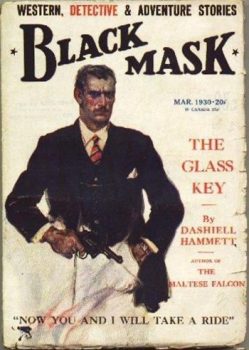 Shelfie – Dashiell Hammett
Shelfie – Dashiell Hammett
Windy City Pulp & Paper Fest – 2025
2024 Series (11)
Will Murray on Dashiell Hammett’s Elusive Glass Key
Ya Gotta Ask – Reprise
Rex Stout’s “The Mother of Invention”
Dime Detective, August, 1941
John D. MacDonald’s “Ring Around the Readhead”
Harboiled Manila – Raoul Whitfield’s Jo Gar
7 Upcoming A (Black) Gat in the Hand Attractions
Paul Cain’s Fast One (my intro)
Dashiell Hammett – The Girl with the Silver Eyes (my intro)
Richard Demming’s Manville Moon
More Thrilling Adventures from REH
Prior Posts in A (Black) Gat in the Hand – 2023 Series (15)
Back Down those Mean Streets in 2023
Will Murray on Hammett Didn’t Write “The Diamond Wager”
Dashiell Hammett – ZigZags of Treachery (my intro)
Ten Pulp Things I Think I Think
Evan Lewis on Cleve Adams
T,T, Flynn’s Mike & Trixie (The ‘Lost Intro’)
John Bullard on REH’s Rough and Ready Clowns of the West – Part I (Breckenridge Elkins)
John Bullard on REH’s Rough and Ready Clowns of the West – Part II
William Patrick Murray on Supernatural Westerns, and Crossing Genres
Erle Stanley Gardner’s ‘Getting Away With Murder (And ‘A Black (Gat)’ turns 100!)
James Reasoner on Robert E. Howard’s Trail Towns of the old West
Frank Schildiner on Solomon Kane
Paul Bishop on The Fists of Robert E. Howard
John Lawrence’s Cass Blue
Dave Hardy on REH’s El Borak
Prior posts in A (Black) Gat in the Hand – 2022 Series (16)
Asimov – Sci Fi Meets the Police Procedural
The Adventures of Christopher London
Weird Menace from Robert E. Howard
Spicy Adventures from Robert E. Howard
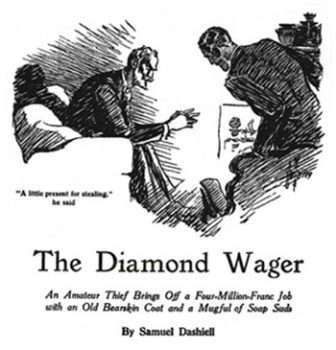 Thrilling Adventures from Robert E. Howard
Thrilling Adventures from Robert E. Howard
Norbert Davis’ “The Gin Monkey”
Tracer Bullet
Shovel’s Painful Predicament
Back Porch Pulp #1
Wally Conger on ‘The Hollywood Troubleshooter Saga’
Arsenic and Old Lace
David Dodge
Glen Cook’s Garrett, PI
John Leslie’s Key West Private Eye
Back Porch Pulp #2
Norbert Davis’ Max Latin
Prior posts in A (Black) Gat in the Hand – 2021 Series (7 )
The Forgotten Black Masker – Norbert Davis
Appaloosa
A (Black) Gat in the Hand is Back!
Black Mask – March, 1932
Three Gun Terry Mack & Carroll John Daly
Bounty Hunters & Bail Bondsmen
Norbert Davis in Black Mask – Volume 1
Prior posts in A (Black) Gat in the Hand – 2020 Series (21)
Hardboiled May on TCM
Some Hardboiled streaming options
Johnny O’Clock (Dick Powell)
Hardboiled June on TCM
Bullets or Ballots (Humphrey Bogart)
Phililp Marlowe – Private Eye (Powers Boothe)
Cool and Lam
All Through the Night (Bogart)
Dick Powell as Yours Truly, Johnny Dollar
Hardboiled July on TCM
YTJD – The Emily Braddock Matter (John Lund)
Richard Diamond – The Betty Moran Case (Dick Powell)
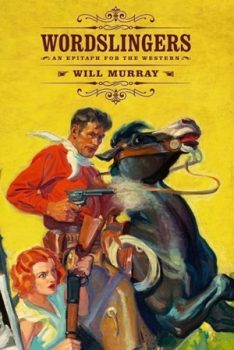 Bold Venture (Bogart & Bacall)
Bold Venture (Bogart & Bacall)
Hardboiled August on TCM
Norbert Davis – ‘Have one on the House’
with Steven H Silver: C.M. Kornbluth’s Pulp
Norbert Davis – ‘Don’t You Cry for Me’
Talking About Philip Marlowe
Steven H Silver Asks you to Name This Movie
Cajun Hardboiled – Dave Robicheaux
More Cool & Lam from Hard Case Crime
A (Black) Gat in the Hand – 2019 Series (15)
Back Deck Pulp Returns
A (Black) Gat in the Hand Returns
Will Murray on Doc Savage
Hugh B. Cave’s Peter Kane
Paul Bishop on Lance Spearman
A Man Called Spade
Hard Boiled Holmes
Duane Spurlock on T.T. Flynn
Andrew Salmon on Montreal Noir
Frank Schildiner on The Bad Guys of Pulp
Steve Scott on John D. MacDonald’s ‘Park Falkner’
William Patrick Murray on The Spider
John D. MacDonald & Mickey Spillane
Norbert Davis goes West(ern)
Bill Crider on The Brass Cupcake
A (Black) Gat in the Hand – 2018 Series (32)
George Harmon Coxe
Raoul Whitfield
Some Hard Boiled Anthologies
Frederick Nebel’s Donahue
Thomas Walsh
Black Mask – January, 1935
Norbert Davis’ Ben Shaley
D.L. Champion’s Rex Sackler
Dime Detective – August, 1939
Back Deck Pulp #1
W.T. Ballard’s Bill Lennox
Erle Stanley Gardner’s The Phantom Crook (Ed Jenkins)
Day Keene
Black Mask – October, 1933
Back Deck Pulp #2
Black Mask – Spring, 2017
Erle Stanley Gardner’s ‘The Shrieking Skeleton’
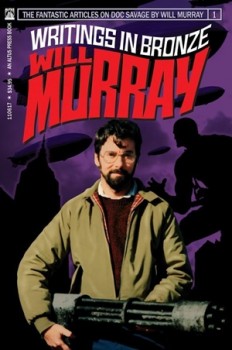 Frank Schildiner’s ‘Max Allen Collins & The Hard Boiled Hero’
Frank Schildiner’s ‘Max Allen Collins & The Hard Boiled Hero’
A (Black) Gat in the Hand: William Campbell Gault
A (Black) Gat in the Hand: More Cool & Lam From Hard Case Crime
MORE Cool & Lam!!!!
Thomas Parker’s ‘They Shoot Horses, Don’t They?’
Joe Bonadonna’s ‘Hardboiled Film Noir’ (Part One)
Joe Bonadonna’s ‘Hardboiled Film Noir’ (Part Two)
William Patrick Maynard’s ‘The Yellow Peril’
Andrew P Salmon’s ‘Frederick C. Davis’
Rory Gallagher’s ‘Continental Op’
Back Deck Pulp #3
Back Deck Pulp #4
Back Deck Pulp #5
Joe ‘Cap’ Shaw on Writing
Back Deck Pulp #6
The Black Mask Dinner
 There are some outstanding names in the ‘New Pulp’ field, but William Patrick Murray’s probably stands above them all. Along with Doc Savage, Will has written Tarzan and The Spider. And he’s quite the Sherlock Holmes writer. Short stories, comic books, radio plays, nonfiction essays and books – Murray has done it all. He created The Unbeatable Squirrel Girl for Marvel Comics, and his collection of essays on Doc Savage, Writings in Bronze, is a must read. I love a good book introduction, and Murray has written some fine ones for Steeger Books. Visit his website Adventures in Bronze.
There are some outstanding names in the ‘New Pulp’ field, but William Patrick Murray’s probably stands above them all. Along with Doc Savage, Will has written Tarzan and The Spider. And he’s quite the Sherlock Holmes writer. Short stories, comic books, radio plays, nonfiction essays and books – Murray has done it all. He created The Unbeatable Squirrel Girl for Marvel Comics, and his collection of essays on Doc Savage, Writings in Bronze, is a must read. I love a good book introduction, and Murray has written some fine ones for Steeger Books. Visit his website Adventures in Bronze.

Bob Byrne’s ‘A (Black) Gat in the Hand’ made its Black Gate debut in 2018 and has returned every summer since.
His ‘The Public Life of Sherlock Holmes’ column ran every Monday morning at Black Gate from March, 2014 through March, 2017. And he irregularly posts on Rex Stout’s gargantuan detective in ‘Nero Wolfe’s Brownstone.’ He is a member of the Praed Street Irregulars and founded www.SolarPons.com (the only website dedicated to the ‘Sherlock Holmes of Praed Street’).
He organized Black Gate’s award-nominated ‘Discovering Robert E. Howard’ series, as well as the award-winning ‘Hither Came Conan’ series. Which is now part of THE Definitive guide to Conan. He also organized 2023’s ‘Talking Tolkien.’
He has contributed stories to The MX Book of New Sherlock Holmes Stories — Parts III, IV, V, VI, XXI, and XXXIII.
He has written introductions for Steeger Books, and appeared in several magazines, including Black Mask, Sherlock Holmes Mystery Magazine, The Strand Magazine, and Sherlock Magazine.
You can definitely ‘experience the Bobness’ at Jason Waltz’s ’24? in 42′ podcast.
Review: A Song of Legends Lost by M.H. Ayinde

Buy A Song of Legends Lost
FORMAT/INFO: A Song of Legends Lost was published in the UK on April 8th, 2025, and will be published in the US on June 3rd, 2025. It is 592 pages long and available in paperback, ebook, and audiobook.
OVERVIEW/ANALYSIS: Everyone knows that only those of noble blood can invoke the ancestors, can call their spirits back to the mortal plane to fight in the wars against the greybloods. Or at least, that's what everyone thinks. But when a young woman in the slums summons a spirit, it sets off a chain reaction of events that will shift the Nine Lands forever. As families fight to determine the fate of the kingdom, one little detail slips through the cracks: not every spirit summoned is an ancestor.
A Song of Legends Lost is a truly unique science-fantasy story that will engross you as it keeps you guessing. It will be tempting for many of you to start this story and within a few chapters proclaim, "I know what's going on!" I certainly did that and I'm here to assure you that, like me, you will be wrong. This blend of magic and technology still has me (pleasantly) confused as to how it all ties together, as we only get a peek behind the curtain by the end of this first book.
The story immediately jumps into some bad situations with multiple characters, plunging you into the middle of things as you meet them. While a few POV characters stay the length of the book, some only stick around for chunks at a time, with the cast of POV characters changing as the story switches from Part 2 to Part 3, etc. This gives us a fairly wide view of the events that are playing out across the kingdom. The author does a good job overall of investing you in the characters, but given how much you jump around, I did occasionally find myself emotionally distanced from some characters more than others.
This is also a story that is working on two levels. On the surface you have the very real, sometimes deadly, political posturing between the monarchy, the powerful religious monks, and the noble families. But there is also a whole second layer of characters pulling strings for completely different reasons. To most, this is about protecting their power and protecting the Nine Lands from the dangerous graybloods. But to others, these power struggles are masking a completely different game. We don't know fully what's going on by the end of things, just that we are still in the dark about quite a lot.
That's where this story may be a bit frustrating for some. We only have a tantalizing glimpse of what's truly going on, with much mystery still to be unpacked in the subsequent sequels. Personally, there is plenty of adventure and growth to be found just in this book alone, but I did plead a little bit at the end to please give me just a liiiittle more detail of what's really going on? Please?
CONCLUSION: But in the end, that's while I'll be back for the sequel to A Song of Legends Lost. The author is clearly just getting started and I am ready to go along for the ride (especially after one especially juicy POV in the epilogue). If you're looking for something fresh and original to dive into, I wholly recommend checking out this story.
Damien Broderick, April 22, 1944 – April 19, 2025
 Damien Broderick
Damien Broderick
Australian writer, editor, and critic Damien Broderick has died, April 19, 2025, just a few days short of his 81st birthday. He died peacefully in his sleep after a long illness. He is survived by his wife and occasional collaborator Barbara Lamar.
I had known Damien quite well online for decades, including interactions in newsgroups and on mailing lists as well as personal correspondence. We met only once, at the World Fantasy Convention in 2017, in San Antonio, TX, where Damien lived at that time; and we had a nice if brief conversation. Damien was showing signs of physical frailty at the time but was still mentally sharp. I had the honor of writing the foreword to his 2012 collection Adrift in the Noösphere, and to reprint a couple of his excellent short stories.
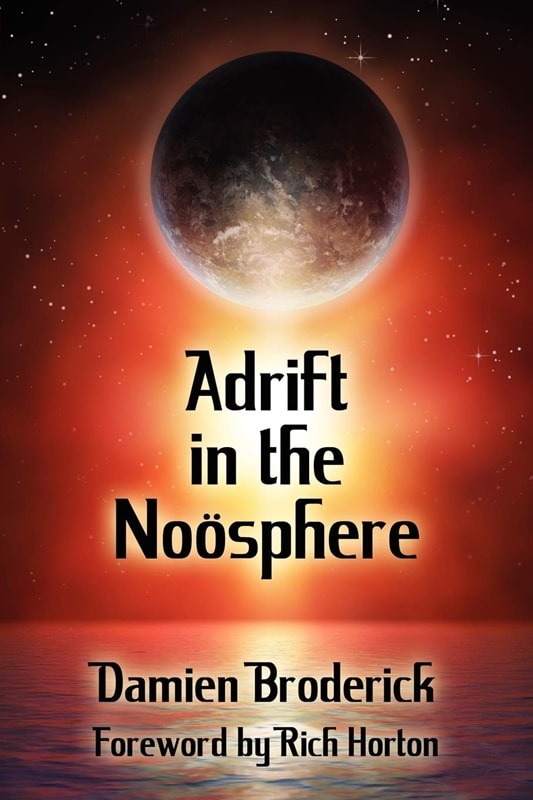
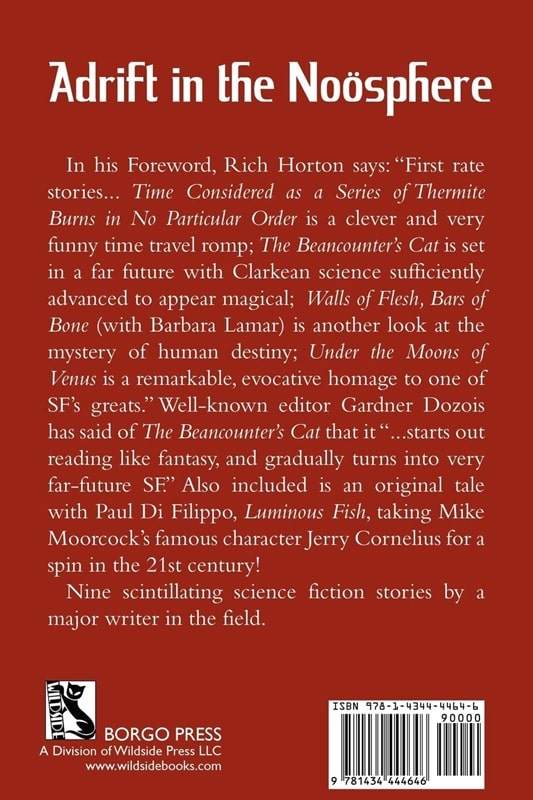
Adrift in the Noösphere (Borgo Press, April 2012)
Damien Broderick was born April 22, 1944, in Melbourne, Australia. He began publishing at the age of 20 with “The Sea’s Furthest End” in the first volume of John Carnell’s original anthology series New Writings in SF.
His first novel, Sorcerer’s World, appeared in 1970 but didn’t gain much notice. (Perhaps deservedly so – I found it less than successful myself and Damien once admitted to me that he regretted some fairly juvenile tricks he played in the novel – he extensively revised it in 1985 as The Black Grail.)
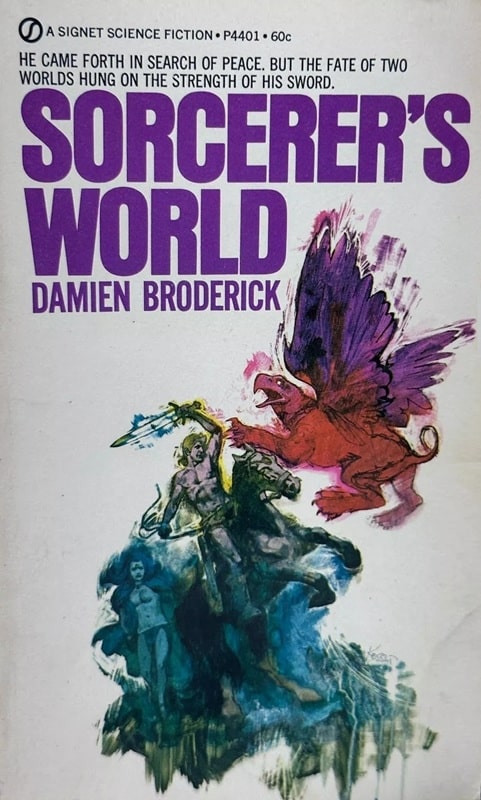
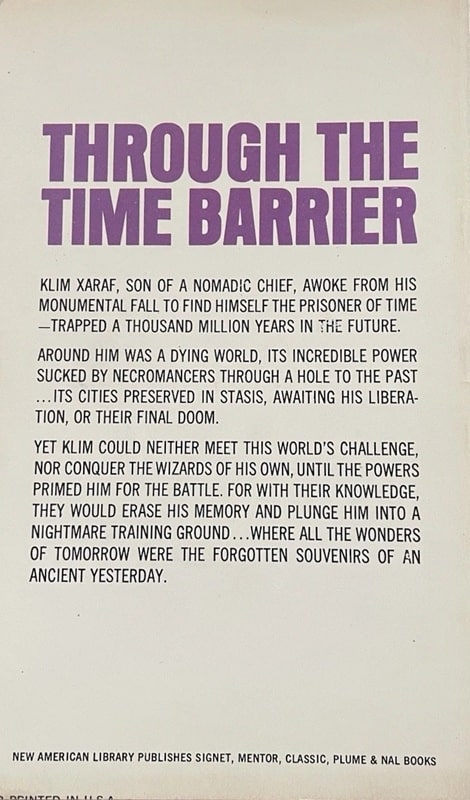

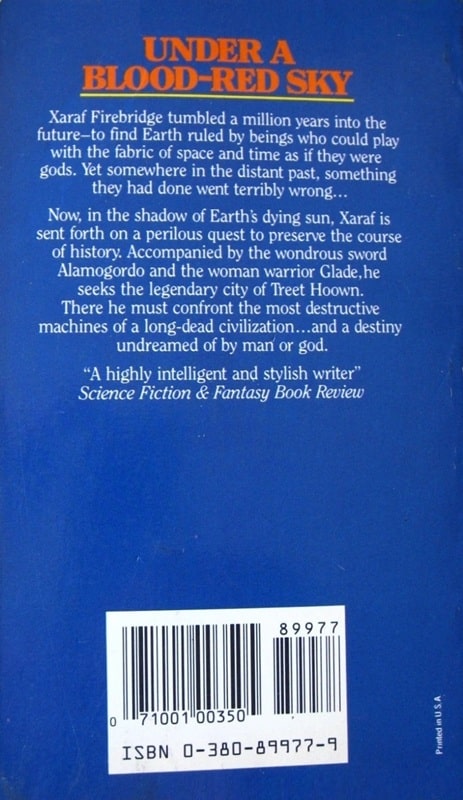
Sorcerer’s World (Signet, October 1970) and The Black Grail
(Avon, September 1986). Covers by Sanford Kossin and Luis Royo
Indeed, Broderick was fond of radically reworking and improving his stories – he revised his first story, “The Sea’s Furthest End,” twice; and also revised The Dreaming Dragons, which won a Ditmar on its first appearance in 1980, as The Dreaming in 2001.
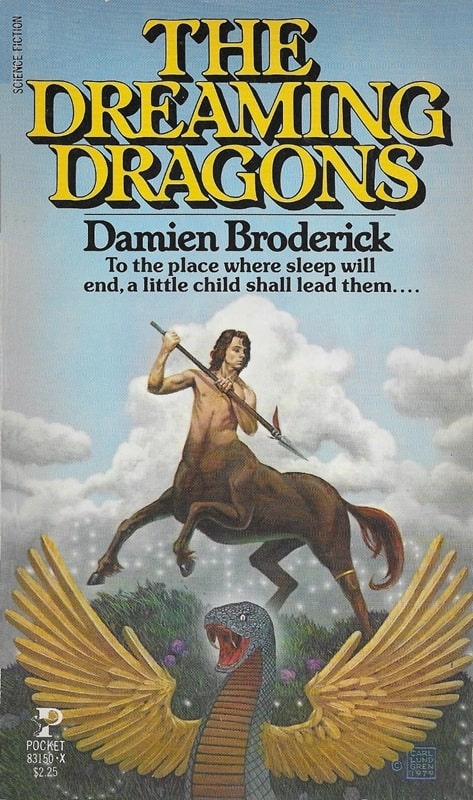
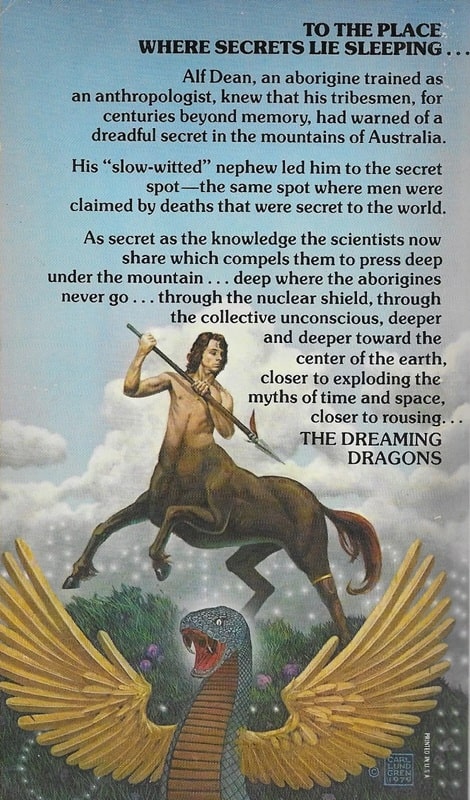


The Dreaming Dragons (Pocket Books, November 1980) and The Judas Mandala
(Timescape, October 1982). Covers by Carl Lundgren, uncredited
Broderick began to gain wider notice with The Dreaming Dragons, and subsequent novels including The Judas Mandala (1982), The White Abacus (1997), and the impressive diptych comprising Godplayers (2005) and K-Machines (2006) earned him much praise, and eventually four Ditmar awards and three Aurealis awards (the two most prominent Australian SF awards.) He was granted the A. Bertram Chandler Award for Outstanding Achievement in Australian Science Fiction in 2010.


Godplayers and K-Machines (Thunder’s Mouth Press,
May 2005 and March 2006). Covers by David Riedy
He also collaborated on a number of novels with Rory Barnes, not all of which were SF – I was impressed by a rather madcap contemporary crime novel called I’m Dying Here (2009) – and with Barbara Lamar he wrote Post Mortal Syndrome (2011). His final “collaborations” were two novels rather radically revising early works by the late John Brunner: Threshold of Eternity (2017) and Kingdom of the Worlds (2021).
Broderick was also a first-rate writer of short fiction. I was profoundly impressed by “The Ballad of Bowsprit Bear’s-Stead (1980) and “The Magi” (1982), and then by a sequence of remarkable work in the 21st century, with several of these stories pastiches of major earlier SF work. The best of this late flowering are “Under the Moons of Venus,” “This Wind Blowing, and This Tide,” “The Qualia Engine,” and “The Beancounter’s Cat”; and in my view Broderick’s late short fiction deserves a closer look.
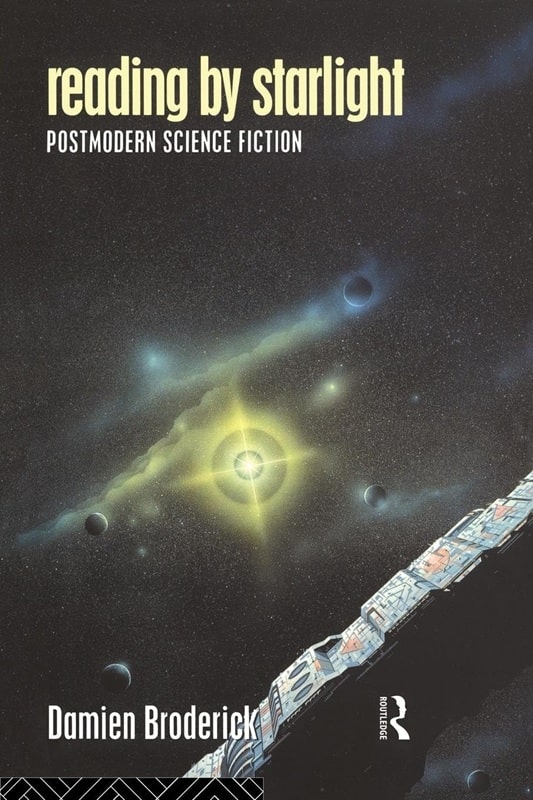
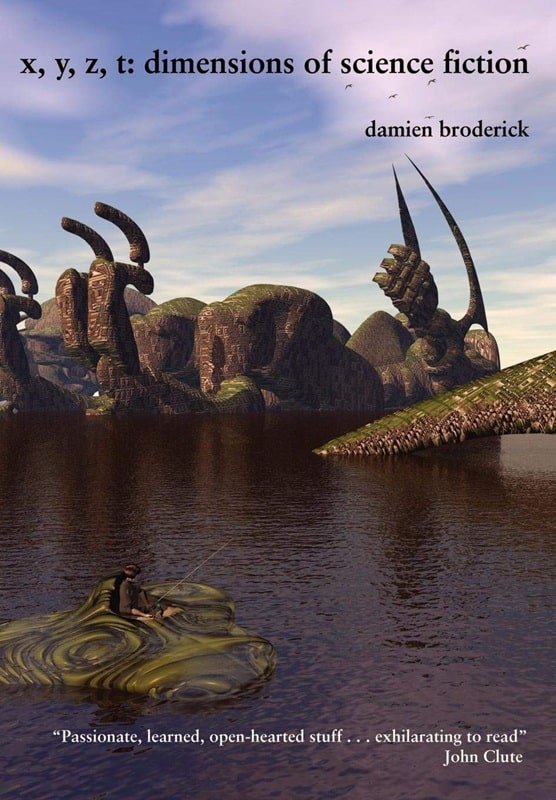
Reading by Starlight: Postmodern Science Fiction (Routledge, 1995) and
X, Y, Z, T: Dimensions of Science Fiction (Borgo Press, January 2004).
Covers by Alan Craddock and Anders Sandberg
He has also written extensively in SF criticism, and in speculative science. Major critical works include Reading by Starlight: Postmodern Science Fiction (1995); Transrealist Fiction: Writing in the Slipstream of Science (2000); and X, Y, Z, T: Dimensions of Science Fiction (2004); as well as, with John Boston, a series of books detailing the history of John Carnell’s seminal UK magazines New Worlds and Science Fantasy issue by issue.
His science books include most notably The Lotto Effect: Towards a Technology of the Paranormal (1992); The Spike: Accelerating into the Unimaginable Future (1997); and Ferocious Minds: Polymathy and the new Enlightenment (2005).
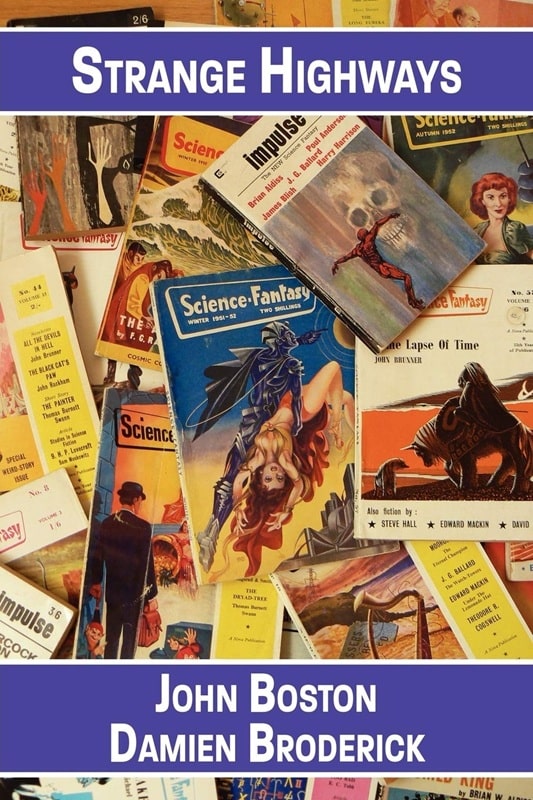
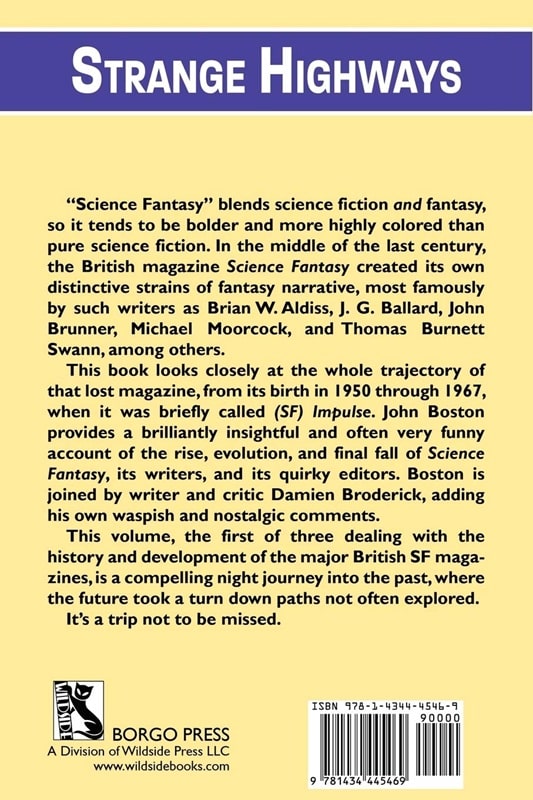
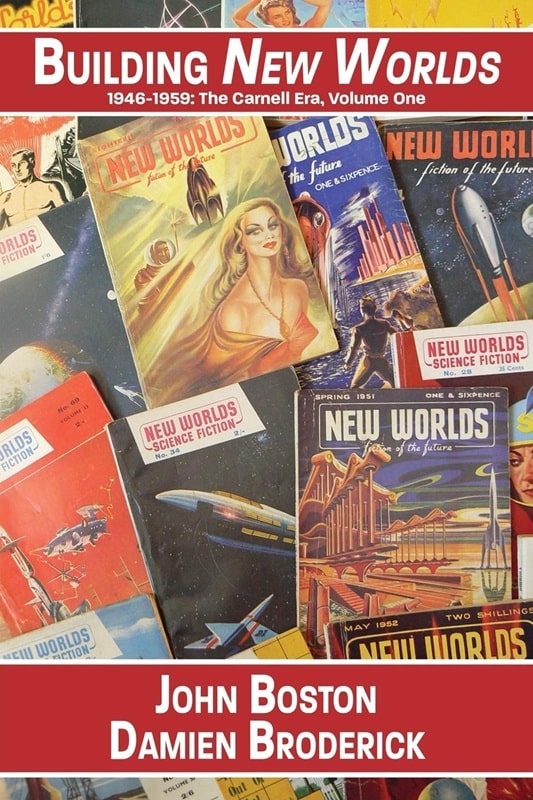
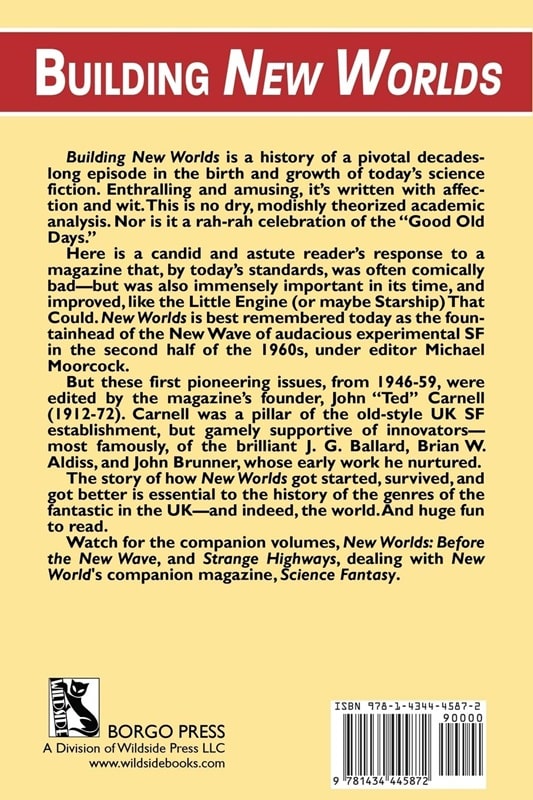
Strange Highways: Reading Science Fantasy, 1950-1967 and Building New Worlds,
1946-1959: The Carnell Era, Volume One (Borgo Press, January 3 and January 29, 2013)
He made contributions as fiction editor of the Australian science magazine Cosmos, and as a prolific anthologist. His anthologies include The Zeitgeist Machine (1977), Earth is But a Star (2001), and, with David Harwell, Centaurus: The Best of Australian Science Fiction (1999).
Damien Broderick was an outstanding science fiction writer – and, to my mind, a somewhat underappreciated one. He was a tireless advocate of Australian SF, in both his anthologies and his critical work. He was an intriguing and rather iconoclastic science writer, very interested in the far future and in very speculative scientific ideas, including paranormal powers. His scientific interests, not surprisingly, also inform his science fiction, much to its benefit (in the The Judas Mandala he seems to have coined the term “Virtual Reality.”)
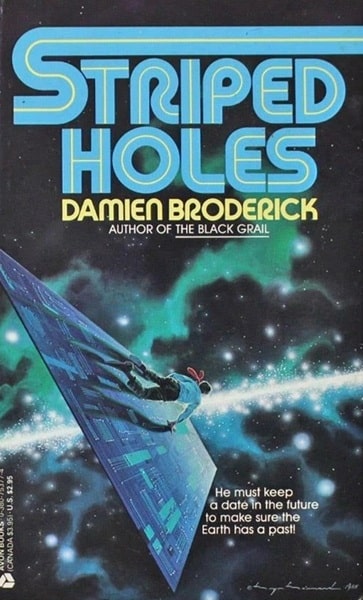
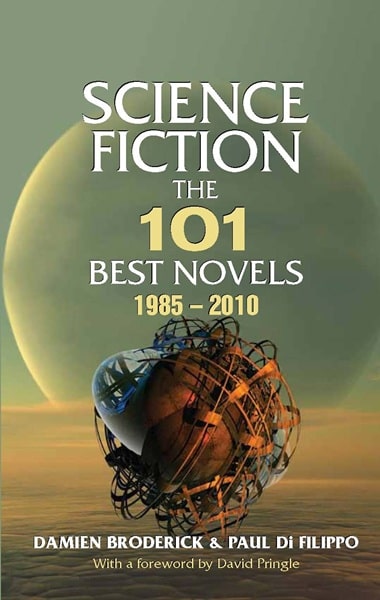
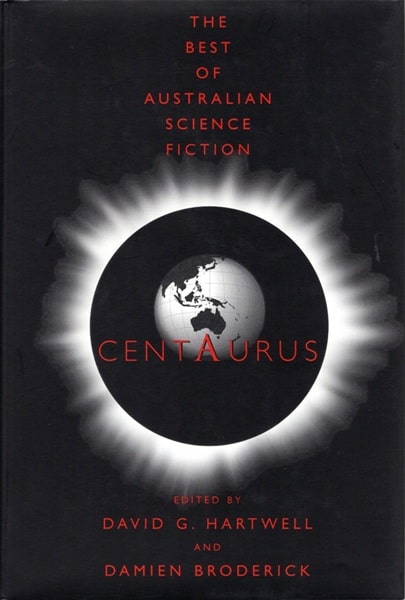
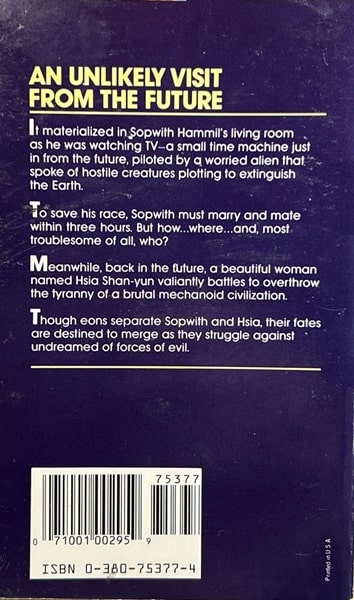
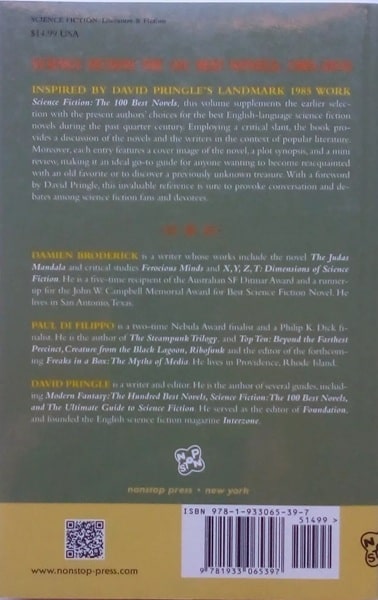
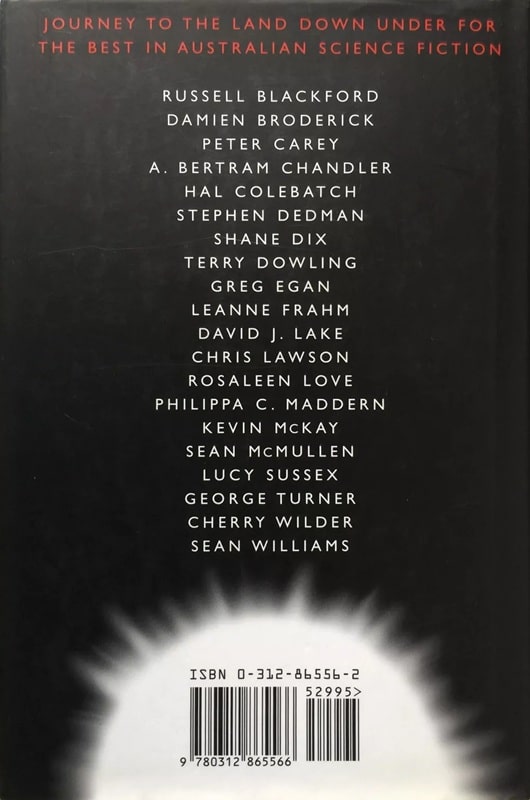
Striped Holes (Avon, November 1988), Science Fiction: The 101 Best Novels 1985-2010,
with Paul Di Filippo (Nonstop Press, 2012), and Centaurus: The Best of Australian Science Fiction,
with David G. Hartwell (Tor, July 1999). Covers by Bryn Barnard, Luis Ortiz, and Peter Lutjen
His range was broad – he wrote fantasy and crime fiction as well as SF, and his fiction could be very funny as well as very dark, sometimes at the same time. I was privileged to know him as well as I did, and I will miss him.
Rich Horton’s last article for us was a Retro-Review of the August 1961 issue of Fantastic magazine. His website is Strange at Ecbatan. Rich has written over 200 articles for Black Gate, see them all here.
Women in SF&F Month: Week 4 Schedule & Week in Review
The fourth week of Women in SF&F Month starts tomorrow, with four new guest posts and a book giveaway coming up this week. Thank you so much to last week’s guests for their fantastic essays! Before announcing the schedule, here are last week’s guest posts in case you missed any of them. All guest posts from April 2025 can be found here, and last week’s guest posts were: “The Long and the Short of It” — A. G. Slatter (The […]
The post Women in SF&F Month: Week 4 Schedule & Week in Review first appeared on Fantasy Cafe.Book Review: Cold Eternity by S.A. Barnes
I received a review copy from the publisher. This does not affect the contents of my review and all opinions are my own.
Mogsy’s Rating: 3.5 of 5 stars
Genre: Science Fiction, Horror
Series: Stand Alone
Publisher: Nightfire | Macmillan Audio (April 8, 2025)
Length: 293 pages | 9 hrs and 38 mins
Author Information: Website
There’s just something irresistible about a haunted-in-space story, which is probably why I always come back to S.A. Barnes. While none of her books have quite crossed that line into “phenomenal” territory for me, I can always count on her to deliver a reliably solid and entertaining experience.
In Barnes’ newest novel Cold Eternity, the premise is immediately intriguing. The story follows Halley Zwick, though she’s been known by multiple names. A woman with a complicated past trying to outrun her overbearing family and a political scandal, she is forced to accept a shady, criminally low paying job just to stay under the radar. The role itself is easy enough, requiring Halley to press a button every few hours and do some rounds. However, it is situated aboard a derelict barge in space known as the Elysian Fields. Originally built to preserve the cryogenically frozen bodies of the rich and powerful with a hope that future medical advancements will allow or their revival, the ship was even repurposed to be a museum for a time but is now nothing but a decaying relic left floating in the void.
Right away, Halley is warned by her mysterious and insufferable boss Karl that she will be expected to perform her duties independently, and that there are areas of the ship that are absolutely off-limits. Preferring to work alone anyway, Halley takes no issue with following his instructions—until strange things start happening on Elysian Fields that go beyond the typical quirks of an aging, crumbling ship. Unexplained noises echo through the emptiness, and Halley thinks she catches sight of someone or something in the shadowed corridors—even though, as far as she knows, the only living souls aboard are Karl and herself, with everyone else locked away forever in cryogenic sleep.
Following in the footsteps of her previous novels Dead Silence and Ghost Station, the author returns with another tense, atmospheric thriller that leans hard into the themes of isolation, paranoia, and rogue technology. Once more, Cold Eternity is packed with unsettling imagery and claustrophobic scenarios which add to the mounting dread. One of Barnes’ greatest strengths lies in her ability to craft eerie, immersive scenarios that have an almost cinematic quality to them. In fact, as someone who recently watched the latest Alien movie Romulus, I could help but draw some inevitable parallels, from the derelict spaceship setting to the glimpses of horrifying monsters lurking in the dark.
Still, although the book had plenty to keep me turning the pages, there were a handful of reasons that kept it from being truly memorable. For one, the pacing felt uneven, with the story taking its sweet time unraveling the central mystery. Without revealing too many spoilers, onboard the Elysian Fields is a cryogenically frozen individual whose memory has been preserved, and with whom Halley has a history. However, this relationship is never explored to my satisfaction, remaining largely surface-level. Similarly, hints about Halley’s troubled past are scattered throughout the book but are mostly withheld until the final stretch, when all is revealed in one big dump. While I typically appreciate a good slow burn when it’s building toward something impactful, here the narrative felt less like a careful calculation and more like stalling.
Another thing that tripped me up was some of the repetitiveness in the plot. The cycle of Halley’s routine which amounted to making rounds, hearing strange noises or seeing strange things, then questioning her sanity became a bit of a slog. I get that readers are supposed to sympathize with the protagonist’s growing paranoia and exhaustion, but the way it was handled made large portions of the novel’s middle section feel unnecessary or redundant. I found myself wishing for more variety in the horror and thrills, or at least some deeper insights into the ship’s macabre history during some of the quieter stretches.
But overall, did I enjoy the book? The answer is yes, which is the most important part. Although not flawless, Cold Eternity is undeniably entertaining and has its fair share of spooky moments. I certainly ate it up in a very short amount of time. Like I said, even though the story is unlikely to stay with me for long, I knew I could count on it for a fun, solid read.
![]()
![]()
Tubi Dive, Part II
 The Beast Within (United Artists, February 12, 1982)
The Beast Within (United Artists, February 12, 1982)
50 films that I dug up on Tubi.
Enjoy!
The Beast Within (1982)This crusty classic from the early 80s exemplifies the beautiful state of the horror genre at that time. This is one of the first writing credits for Tom (Fright Night, Chucky) Holland, and he wears his influences on his sleeve. HPL is well with the theme (evil possession, familial curses) and a couple of character names (Dexter Ward, the Curwins), but for me the primary influence was Hammer’s Curse of the Werewolf (a woman is raped by a foul individual, her subsequent offspring has a hard time of it), although this film could easily be called Curse of the WereCicada — such is its nutty premise.
The young man who has a ‘beast within’ seems to be possessed by his criminal father (later to be echoed in Chucky?), is played quite well by Paul Clemons in essentially a duo role, and anything with Ronny Cox in it is automatically a hit in my book. That said, the film is justifiably derided for some of the acting, and the entire storyline, but it’s a glorious smorgasbord of sweaty, sleazy characters and over-the-top latex bladder effects.
6/10
 The Dunwich Horror (American International Pictures, January 14, 1970)
The Dunwich Horror (1970)
The Dunwich Horror (American International Pictures, January 14, 1970)
The Dunwich Horror (1970)
Yes, I can hear some of you clutching at your pearls as I write this, but barring a couple of clips here and there, I had never actually seen this one before.
As Lovecraft adaptations go, I guess you could say this is one of the most faithful, what with familiar names and places and ‘Yog-Sothoth’ being yelled approximately 300 times, but it is a far cry from the original source material.
Corman must have read the description of Wilbur Whateley (“goatish”) and interpreted that as ‘horny,’ because this version of WW just wants one thing, and that’s Sanda Dee naked on a sacrificial shagging stone. This is Dee’s first ‘mature’ film, and I wasn’t impressed — she’s a bit bland in this, however, Dean Stockwell as Wilbur is amazing. Now there is an actor who is FULLY committed. The monster in the attic is a bit of a letdown, depicted more like a colour out of space than the sort of tentacled beastie that butters my toast, but the production design is rather lovely, and there are some great matte paintings on show.
Fun for viewers who like gibbering madness and drugged tea.
6/10
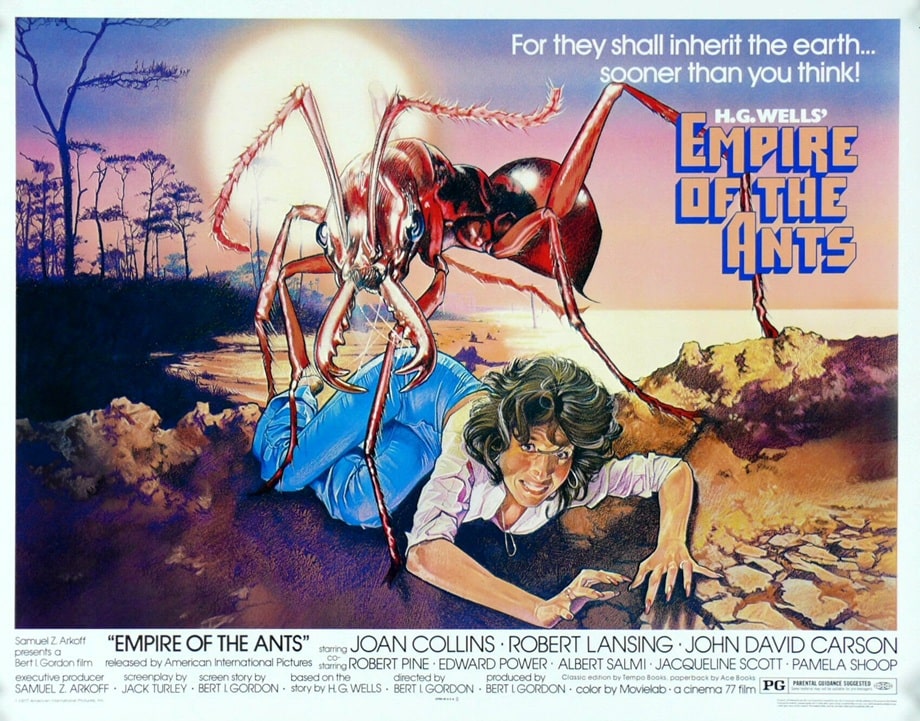 Empire of the Ants (American International Pictures, July 29, 1977)
Empire of the Ants (1977)
Empire of the Ants (American International Pictures, July 29, 1977)
Empire of the Ants (1977)
During that heady time in the mid 70s when so many creature features came out (Jaws, Grizzly, White Buffalo, King Kong et al), this one popped out at the tail end of the boom. I’m a sucker for ant movies (Phase IV, Naked Jungle), and this movie had assumed near mythical status for me, based on a few late-night clips on TV when I was a youngster, and a black and white picture of Joan Collins looking unperturbed, from one of the books that shaped my youth, Sci-Fi Now.
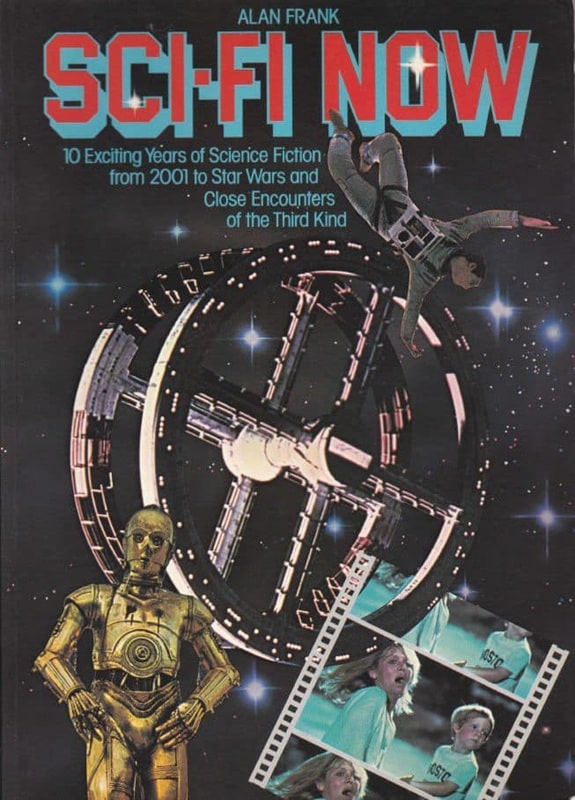

Sci Fi Now by Alan Frank (Octopus, January 1, 1978),
containing the classic still of Joan Collins in Empire of the Ants
Watching it now, as a bitter old man, it’s a bit rubbish.
Directed by Bert I. Gordon, from the H. G. Wells story, it’s a cheesy romp, and set mostly in the Florida Everglades. In the last third of the film the setting moves to a pheromone-controlled town, and this would have made a much better film, however, the preceding snooze-fest in the woods is a bit of a slog. Dodgy effects and horrible sound effects are the icing on this ant-ridden cake.
5/10
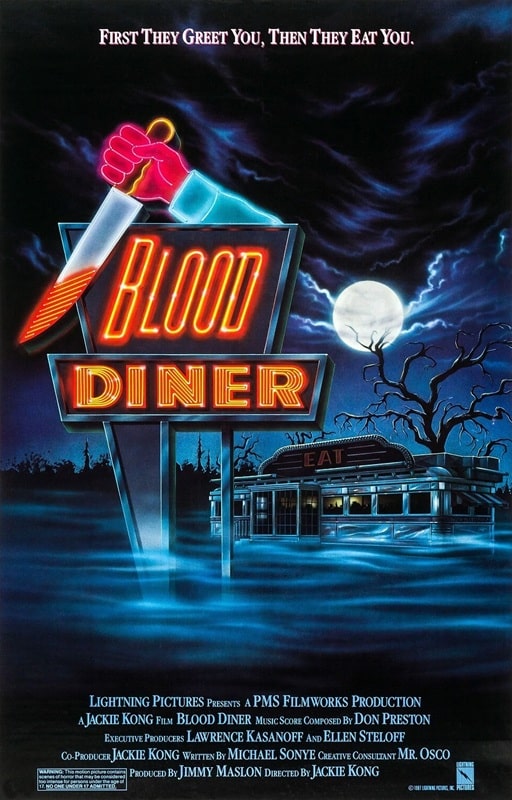
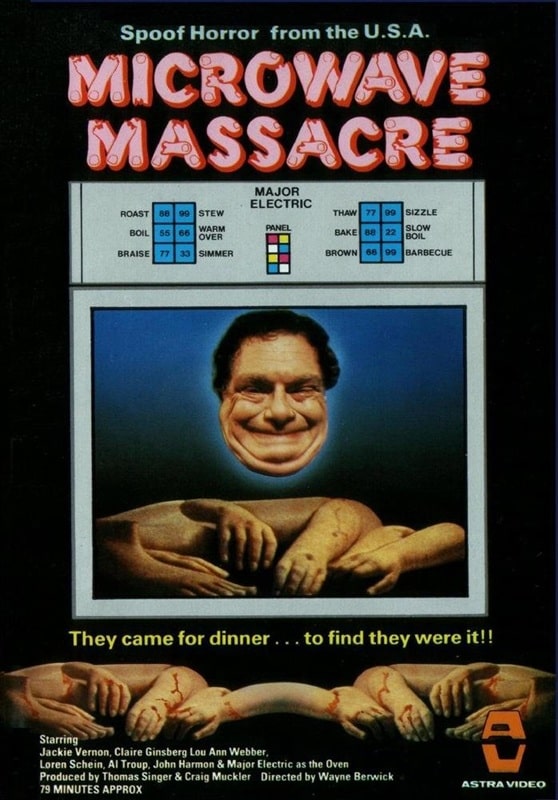
Blood Diner (Lightning Pictures, July 10, 1987)
and Microwave Massacre (Reel Life Productions, 1979)
Regrets, I’ve had a few. Usually after watching a sharksploitation film full of bad actors. However, the only regret I have after watching this stunningly bonkers horror comedy from Jackie Kong, is that I didn’t see it in 1987, thus depriving me of 36 years of annual re-watches.
I’m not sure how she did it, but Kong tapped into the under-developed brain of a 14-yr-old boy and made the perfect film.
It’s ludicrous, gory, offensive, daft as a badger on a hang glider, and quite brilliant — I wholly get why it has achieved such a cult status.
The abysmal acting is just the icing on the cake in this story of a couple of dumb brothers trying to resurrect an ancient, evil goddess by murdering women and using their internal organs in a ritual. All other body parts are served in their diner. As is befitting a mid-80s horror romp, this is full of nudity, sexism, practical dismemberments, and banging tunes.
Highlights include a deep-fried head, a funk band brass section dressed as Hitler, a brain in a jar, death by stalactite, an exploding quiff, an extremely long sequence of someone getting repeatedly run over, someone in a Ronald Reagan mask shooting up a studio full of topless cheerleaders, and the perviest detective you’ll ever meet.
It’s Texas Chainsaw Massacre meets The Naked Gun.
Insane.
10/10
Microwave Massacre (1979)An oddball flick, this does tangentially feature a microwave, but no massacres. To be honest, I’m still coming to terms with whether or not I enjoyed it. The film is supposed to be a farce, but its humor is neither insightful, nor funny. If anything, it plays like an early 70’s smut flick on quaaludes. The acting is amateur at best, and the women are portrayed in only two ways, sexual playthings, or screeching harpies. All are eaten though. The lead character, Donald, is played by Jackie (Frosty the Snowman) Vernon in the most laid back style I have ever witnessed. It’s as if he had just wandered into each scene and someone whispered a line to him, which he would repeat with zero emotion. All very strange, even more so when he turns to camera and just stares at us.
The horror elements are fairly cheesy, as are the nudity scenes (although the first one we get is more disturbing than cheesy), but the ACME Rubber Hand Co. must have made a killing that year.
One for true purveyors of weird stuff.
5/10

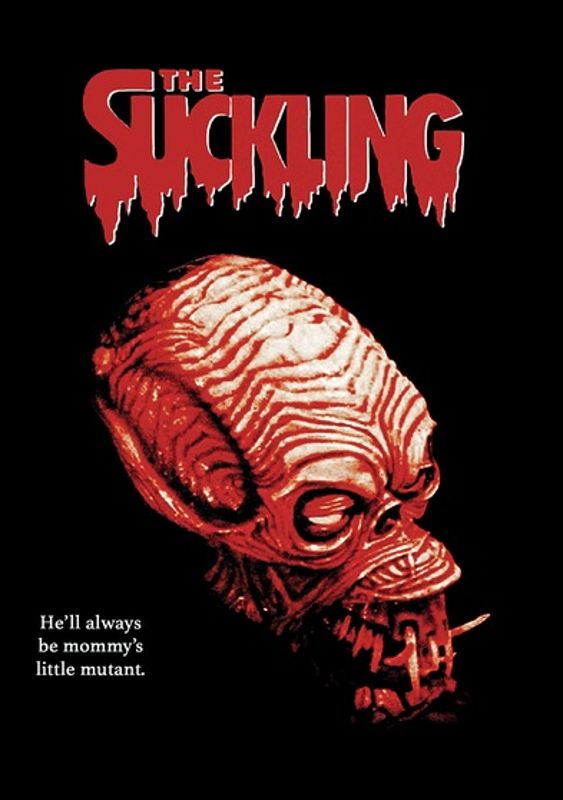
The Shout (Rank Film Distributors, June 16, 1978)
and The Suckling (Hypercube, September 24, 1990)
It’s a funny old world, ain’t it. How a film slips by a purveyor of horror, especially British horror, like myself never fails to intrigue me — yet here we are.
The Shout is not only based on a short story by Robert Graves, but it won a top award in Cannes that year, is a classic bit of British Folk(ish) horror in the same vein as The Wicker Man, and it had eluded me all these years. Now, thanks to Tubi’s unrivalled collection, I have finally seen it, and it’s staggeringly good.
It helps that you got the likes of Alan Bates (at the height of his dangerously sexy period), John Hurt, Susannah York, and every excellent English character actor including fresh-faced Tim Curry and fresher-faced Jim Broadbent in the cast. The story is fairly bonkers — a stranger (Bates) inserts himself into the cozy cottage life of Hurt and York, and proceeds to take over, cuckolding Hurt and claiming York through aboriginal sorcery. Yep, aboriginal sorcery. Apparently he had lived in Australia for 18 years, fallen in with an aboriginal shaman, and learned some dark magics, not least of all the ability to kill a person with a single shout.
The story is bookended by a cricket match between the inmates of an asylum and their carers, and the characters are all connected by this strange game.
It also helps that the exteriors were all shot in Devon, and that the direction and editing are super-interesting, bordering on experimental. The director, Jerzy Skolimowski, wisely keeps many events in the film ambiguous, keeping the viewer on their toes and questioning everything.
Highly recommended if you like 1970s British horror, or modern-day equivalents by the likes of Ben Wheatley, Ari Aster or Robert Eggers.
10/10
The Suckling (1990)Take a look at the official synopsis, and then decide if you want to carry on reading:
When a pregnant woman goes to an illegal abortion clinic doubling as a brothel, her aborted mutant fetus sets out on a violent rampage.
Still here?
Yes, this one is offensive as all hell. The premise is barking mad, the acting is dire (more on this later) and the direction is all wrong, and yet… and yet I found myself laughing so much at this film that I’m loath to give it a bad score, even though it deserves it. The laughs, of course, were unintentional and only caused by terrible lines and delivery of said lines. About 15 minutes in, I suddenly realized why I was enjoying it so much; it’s like a feature-length episode of Garth Marenghi’s Dark Place — there’s even an actor who not only looks like Richard Ayoade, but delivers his lines exactly like Dean Learner.
The fast-growing fetus monster is a slightly goofier version of Rawhead Rex (if that’s possible), and the actual kills are mostly off-screen — I can’t help wondering if this was an edited version I saw.
A particular highlight is the foley added to the film. Every object, ceiling fan, footstep, and door kick is given a loudly incorrect sound effect — you have to watch it just for this.
Bottom line — it’s terrible, awful acting, ridiculous premise, silly fx.
Highly recommended.
6/10
Previous Murkey Movie surveys from Neil Baker include:
Tubi Dive, Part I
What Possessed You?
Fan of the Cave Bear
There, Wolves
What a Croc
Prehistrionics
Jumping the Shark
Alien Overlords
Biggus Footus
I Like Big Bugs and I Cannot Lie
The Weird, Weird West
Warrior Women Watch-a-thon
Neil Baker’s last article for us was Part I of Tubi Dive. Neil spends his days watching dodgy movies, most of them terrible, in the hope that you might be inspired to watch them too. He is often asked why he doesn’t watch ‘proper’ films, and he honestly doesn’t have a good answer. He is an author, illustrator, teacher, and sculptor of turtle exhibits. (AprilMoonBooks.com).
Don’t Go into the Nursery! 6 Haunting Novels with Scary Children
If you are looking for a chilling read that will make you question the innocence…
The post Don’t Go into the Nursery! 6 Haunting Novels with Scary Children appeared first on LitStack.
Junkyard Cats - Book Review
 Junkyard Cats (Junkyard Cats #1)by Faith Hunter
Junkyard Cats (Junkyard Cats #1)by Faith HunterWhat is it about:After the Final War, after the appearance of the Bug aliens and their enforced peace, Shining Smith is still alive, still doing business from the old scrapyard bequeathed to her by her father. But Shining is now something more than human. And the scrapyard is no longer just a scrapyard, but a place full of secrets that she has guarded for years.
This life she has built, while empty, is predictable and safe. Until the only friend left from her previous life shows up, dead, in the back of a scrapped Tesla warplane, a note to her clutched in his fingers - a note warning her of a coming attack.
Someone knows who she is. Someone knows what she is guarding. Will she be able to protect the scrapyard? Will she even survive? Or will she have to destroy everything she loves to keep her secrets out of the wrong hands?
What did I think of it:I was warned by a friend that this was a weird series, still I was curious enough to give it a try.
And I what she meant.This is a futuristic world with lots of freaky stuff, so if you're not into freaky science SciFi skip this series.
Still, I had a good time with this book.There was a bit too much fighting at times. I would have liked it better if there was a better balance between the tense action and more relaxed moments.But all in all this was an interesting and intriguing read. I really liked Shining and her employee/friend Matteo. And of course there are the junkyard cats!
There is a lot going on and explained in this book, and maybe Hunter chose to get in so much action to make all the explaining less boring (which it wasn't imo).By the end it's clear what Shining's next step will be, and I will get my trotters on the next book to see where this whole series will lead to.
Why should you read it:It's an intriguing Futuristic Read.
Women in SF&F Month: The Essential Patricia A. McKillip Cover Reveal
For Women in SF&F Month today, I’m revealing the cover of The Essential Patricia A. McKillip—and giving away two galleys of the 30th anniversary edition of her fantasy novel The Book of Atrix Wolfe! This is an honor since I love her writing, from the magic and beauty of her prose to the wit and wisdom that shines through her stories. She is the author of two of my favorite novels, The Changeling Sea and The Forgotten Beasts of Eld, […]
The post Women in SF&F Month: The Essential Patricia A. McKillip Cover Reveal first appeared on Fantasy Cafe.The Inheritance: Chapter 1
Warning: R rated for fantasy violence and adult themes.

We are at war.
This war is not about wealth, resources, or territory. It’s a war of biological extermination. The very existence of humanity is at stake.
The moment the first gate burst, sending a monster horde to rage through our world, it brought us unimaginable suffering, but it also awoke something slumbering deep within some of us, a means to repel and destroy our enemy. Powers beyond comprehension. Abilities that are legendary.
The war is ongoing. If you are a Talent, your country needs you. The world needs you. Be the hero you always wanted to be.
Take my hand and answer the call.
Elias McFeron
Guildmaster of Cold Chaos
Chapter 1Health insurance with $1,000 maximum family deductible.
Prescription drug coverage with 80% discount off list prices.
The first time I heard about gates, I imagined them to be these portals glowing with a magical blue light. Too many video games, I guess. They were nothing like it. This one was a hole. A deep, black, vertical hole that punched through reality, swirling with pale mist.
It appeared in front of the Elmwood Park Rec center. To the left was Elmwood Public library, all red brick and tinted windows. To the right was a funeral home followed by perfectly ordinary, three-story boxes of apartment buildings covered in tan stucco. And straight ahead was an interdimensional tear. Just another Monday.
If someone told me ten years ago that I would be standing in front of a hole leading into a dimensional breach and preparing to go inside, I would’ve politely nodded, walked away, and later told Roger I’d met an unhinged person. Of course, ten years ago I was thirty, happily married, with a daughter in elementary school, a son just out of diapers, and a low-risk private sector job I loved. A different life that belonged to a different Adaline.
The future looked bright back then. Until the invasion shattered it.
Free emergency medical care when injured in the line of duty.
I took this job for the benefits, and when it got to me, like now, I recited them in my head like a prayer.
Dental, $150 deductible, 50% off braces.
Things that came with age and children: appreciation of the dental plan with orthodontics. Braces were hellishly expensive.
Vision plan, 15% discount off glasses and contacts.
The gate gaped like a dark maw.
At least thirty-five yards tall. Maybe taller. The threat scale ran from blue to red, and the prep packet put this gate at the low orange risk level. On a dying scale of 1 to 10, it was about 7.
This was my seventy-eighth gate. I’d gone into orange gates many times before. I didn’t want to go into this one. It made my hair stand on end. And the presence of the funeral home wasn’t helping.
“Ominous sonovabitch, isn’t he?” Melissa murmured next to me.
“Mhm.”
The mining foreman crossed her arms on her chest. She was a tall woman, two years older than me, with auburn hair she religiously dyed every four weeks and the kind of face that said she had everything under control. We met years ago, on one of my earlier gate dives, bonded over kids, and stayed friendly ever since.
Melissa ran her mining crew like a well-oiled machine. She didn’t get rattled, but she was staring at this gate like it was about to reach out and bite her. Something about this hole set both of us on edge.
Melissa narrowed her eyes. “Anja, tie your damn shoelaces.”
One of the younger miners rolled her eyes and crouched. “Always on my case…”
“Exactly. I am always on your case. I’m on everyone’s case. If we have to run for our life out of that gate, I don’t need any of you tripping over your feet, because I’ll have to double back and get you. You have two toddlers to come back to.”
“Yes, Mother.”
Melissa heaved a sigh. “Everybody is full of sass today.”
Around us the mining crew checked their gear, twelve people in indigo magnaprene coveralls and matching hard hats. Nobody seemed unusually worried. Toolbelts were adjusted, rock drills and shears tested, the generator and floodlights on three industrial carts inspected. The usual.
The escort, five combat grade Talents in dark blue tactical armor, had done their precheck ages ago and were now waiting. Aaron, a tank class, sat on a crate, leaning against another crate, his eyes closed. His massive adamant-reinforced shield rested on the ground next to him. Three strikers mulled about, armed with SIG Spear rifles and a variety of sebrian blades for when the ammo ran out.
London, the escort unit leader, surveyed the mining crew. He was a blade warden, which meant he could both dish out lethal damage and summon a protective forcefield which made him invulnerable for several minutes. He carried a brutal-looking tactical axe, and on the few occasions I saw him use it, he cut through transdimensional monsters like he was chopping salad.
Both the mining crew and the escort wore blue, marked with the lightning blade emblem of the Cold Chaos Guild. I wore a white hard hat and grey coveralls with a patch of Dimensional Defense Command on my sleeve. The mining crew and the escorts were private contractors, while I was a representative of the US Government. My official title was Dimension Breach Resource Assessor. The guilds called us DeBRAs, and they were supposed to keep us alive at all costs.
If things went to shit, the tank would put himself between the mining crew and the threat, the strikers would cut down whatever got past him, and London would grab me, wrap us both in his defensive force field, and drag me out of the gate so I could report the disaster to the DDC. Of everyone here, I was the least expendable, as far as the government was concerned.
It didn’t make me feel any better.
The mist swirled, sending tendrils of dread toward me. I resisted the urge to hug myself.
20 days of recuperation leave.
Which was long overdue. Maybe that was part of the problem.
Basic Housing Allowance.
That was a big one. BHA was the only reason I was able to keep the house after Roger left.
Child Tuition Assistance.
CTA was another big one. It helped me cover tuition for Hino’s Academy. Things were tight but I hadn’t missed a payment yet. The school had stellar academics, but I picked it for their underground shelter. If a gate ruptured and a flood of invading monsters washed over the city, Tia and Noah would be safe until the military and the guilds repelled it. Competition for the school was fierce, but since I was DDC, the kids were given special treatment along with the children of guild members. Advertising that Hino was the school of choice for the children of Talents was good for the academy’s prestige.
“Ada, London is checking you out again,” Melissa said.
Next to me, Stella, Melissa’s baby-faced protégé, snickered quietly. She was twenty, and flirting was still exciting.
A large German Shepherd sitting at Stella’s feet panted as if laughing. Bear came from an illustrious line of police dogs with heroic careers. She had the typical GS coloring, big brown eyes, and huge ears, and petting her was off-limits. I’d asked before and was told no. Bear was working like the rest of us. Petting would be distracting.
“Brace yourself, he’s coming this way,” Melissa murmured.
I turned. London was heading straight for us. His real name was Alex Wright, and he was from Liverpool, but everyone called him London anyway. People with combat talents were resistant to wear and tear, and at forty-five, London was still in his prime, tall, broad-shouldered, with blue eyes, wavy brown hair, and an easy smile. His job was to keep the miners and me safe, and since he was my designated babysitter, he and I spent a lot of time in close proximity. Even so, he’d been paying me too much attention lately.
London stopped by us. “Everything okay here?”
“Everything was fine until you showed up,” Melissa said.
He grinned at her. “Just doing my due diligence.”
They usually had a fun back-and-forth going. It put people at ease. I worked with guilds all over the Eastern US. In some mining crews, tension was so thick you could cut it with a knife and make a sandwich. Cold Chaos was light and bright.
“Are you worried about us, Escort Captain?” Stella tilted her head, and her mane of dark curly hair drooped to one side.
“It’s my job to worry, Miles. Have you been doing your sprints?” London asked.
“I have,” Stella told him. “Fifteen seconds for the dash.”
A hundred meters in fifteen seconds was damn impressive. It was good to be young. God, I was almost twice her age. How the hell did it even happen? I was twenty only a few years ago, right?
“Not bad,” London said.
“I can beat both of them,” Stella reported, nodding at me and Melissa.
“Talk to me after you pushed three human beings through your hips and put on forty pounds from the stress of keeping them alive,” Melissa told her.
London turned to me. “Where do you dash, Ada?”
Why are you doing this? You know nothing will come of it. “Gate Park.”
All government gate divers ran – not for distance or endurance – but to survive. A 100-meter sprint, a walking lap around the track, rinse and repeat for an hour, then go home, and take ibuprofen for the aching knees. Three times a week. Five would be better, but three was what I usually managed. DDC had mandatory PT tests every six months to keep us in shape. When a noncombatant faced a threat in the breach, running to the gate was the best and often the only way to stay alive.
“Maybe I’ll join you sometime,” London said.
Again, why? “You’re out of my league. It would be a waste of your time.”
“Never,” he told me.
“How fast do you dash?” Stella asked London.
“Let me put it to you this way: I could pick Ada up and give you a three-second head start, and you still wouldn’t beat my time.”
London smiled at us and moved on.
“Is he lying?” Stella asked Melissa.
“No,” the mining foreman told her. “Combat Talents are on another level. We can’t keep up.”
London was sending out all sorts of interested signals. He was nice to look at, charming, and he’d clearly been around the block enough to know what he was doing. By now, he’d had enough experience not to fumble and enough patience to pay attention when it mattered. If I agreed to go on a date, it would go smoothly and end well.
However, the DDC forbade fraternization with guild members. I was supposed to stay neutral and refrain from forming any personal attachments. Even the work-hours friendships like the one with Mellissa were frowned upon. Getting involved with a guild Talent would get me fired, and I had two kids and a mortgage. As fun as London would be in bed – and he would be very fun – he wasn’t worth losing my job.
My phone vibrated. Hino Academy. Please don’t be a problem, please don’t be a problem…
“Yes?”
“Ms. Moore?”
Gina Murray, the assistant principal. That wasn’t good.
“We have a problem.”
Of course, we do.
A woman emerged from the gate and waved. A scout the assault team had left behind. An hour had passed without incident, and it was time to go in.
“Alright people!” London called out. “You know the drill. Last gear check. Move out in two minutes.”
“What happened?”
I needed to fix this fast. Phones didn’t work inside the gate, and London had to stick to schedule and account for any delay. If we went inside five minutes late and a disaster struck, even if it was completely unrelated, the Guild would drag him over hot coals for it.
“Tia left campus without permission.”
Melissa rolled her eyes.
“Okay.” What was that kid doing…
“Before she left, several students and a member of the faculty heard her make a self-harm threat.”
“What?”
“We are required to contact the police…”
“Please don’t do anything. Let me speak to her first. I’ll call you right back!”
I ended the call and stabbed Tia’s number in contacts.
Beep.
She wouldn’t. Tia wouldn’t. Not in a million years.
Beep.
Beep.
I knew my daughter. She would not.
“Yes, mom?”
“Are you going to hurt yourself?”
“What?”
The mining crew formed up in front of the gate. London gave me a pointed stare.
“Oh look, Stella’s dog is malfunctioning,” Melissa said too loud.
Stella pretended to shake Bear’s leash. “Won’t turn on. Something broke.”
London headed for us.
“The Academy called. You told them you were going to hurt yourself and left campus.”
“Well, you know what, maybe I should kill myself because they just assigned us a fifth essay due next week…”
“Tia!” I couldn’t keep the pressure from vibrating in my voice. “This is really serious. I need you to be honest with me. Are you thinking of hurting yourself?”
London cleared the distance between us. “What’s the hold up?” he asked quietly.
“Give her a minute,” Melissa told him. “It’s her kid.”
“No. I was in the cafeteria, I failed Latin again, and then there was the fifth essay due…”
London met my gaze. “Three minutes.”
Thank you, I mouthed. Three minutes was a gift.
“…Mr. Walton made a snide comment about not applying myself and I said, ‘Just kill me, it will solve all my problems…’”
And…?
“…And then I went to get Starbucks! I always sneak out to get Starbucks. Everybody does it. Nobody cares!”
It wasn’t a real threat. Someone overreacted. The relief washed over me like an icy flood. Not a real threat.
“Mr. Walton hates me!”
“Tia, I’m about to go into the gate. The school wants to call the cops.”
“What? Why?!”
“If this happens, things will get very complicated, and I can’t help, because I’ll be inside the breach. I need you to return to school and fix this.”
“I was already on my way! I’m almost there.”
I started toward the gate.
“I’m walking into the school building right now.”
“Kiss their ass, do whatever you need to, but make sure you fix it. I love you.”
“I love you too. Mom…”
The gate loomed.
“Here we go,” Melissa muttered.
“I have to go, Tia.”
“Mom!”
“Yes?”
“Don’t die!”
“I won’t,” I promised.
“Remember,” London called out. “We go in together as one, we come out together as one. Nobody gets left behind.”
The mist swirled around my legs. I hung up, took a deep breath, and stepped into the dark.
#
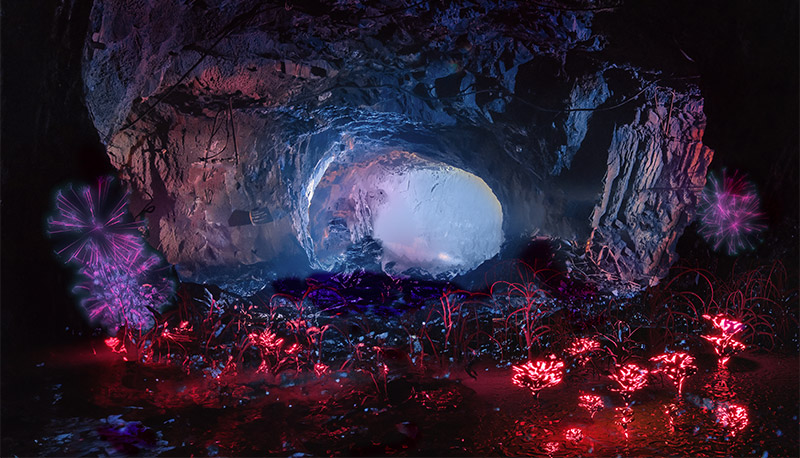
Stepping through the gate felt like trying to push your way through dense, rubber-thick Jello.
I blinked, trying to adjust to the low light.
A stone passage stretched in front of me, illuminated by patches of bioluminescent lichens, moss, and fungi. They climbed up the walls, glowing with turquoise, green, and lavender, some curling like fern sprouts, other spreading in a net like bridal veil stinkhorn mushrooms.
The otherness slapped you in the face. It didn’t look familiar, it didn’t smell right, and it didn’t feel like home. The hair on the back of my neck rose. Fear dashed down my arms like hot electric needles. I wanted out of this gate. The urge to turn around and run back to the familiar blue sky was overwhelming.
This burst of panic used to happen every time I entered a breach. I’d tried everything in the beginning: counselling, breathing, counting, cataloging random things I saw… My primary prescribed some Xanax, which I couldn’t take because it was strictly off limits for gate divers. Slowed the reaction time down too much.
Medication wouldn’t have worked anyway. Nothing had worked until one week we got a cluster breach. Four gates opened simultaneously in close proximity, and I was the only DeBRA in range. I went through four breaches in forty-eight hours, and by the middle of the third my panic switch got permanently broken. This anxiety was an unwelcome blast from the past, and it needed to go away right now.
It was probably the residual stress from the school call.
“Alright,” Melissa called out. “We have a limestone cave biome. The assault team found a large chamber with promising mineral deposits, so we’ve got a bit of a hike. Watch your step. Do you remember how Sanders fell into a crevice and got stuck, and we spent ten minutes pulling him while he was farting up a storm and giggling? Don’t be Sanders.”
Sanders, a tall bear of a man in his mid-thirties, chuckled into his reddish beard. “I didn’t have chili this time, I swear!”
A light laughter rippled through the crew. Melissa was going right down her playbook: item one, put everyone at ease the moment the crew stepped into the breach; item two, reach the mining site; item three, profit.
“We have Adaline Moore with us this morning. She is the strongest DeBRA in the state, which means if there is good pay in this hellhole, she will find it for us,” Melissa announced. “Another day, another dollar. Isn’t that right, Assessor?”
“That’s right.” I matched her tone. “Living the dream.”
Another ripple of laughter.
“Once more…” one of the miners called out.
“Don’t you say it!” Melissa growled. “You know better!”
“…into the breach!”
“Damn it, Hotckins!”
The guild superstition held that if you said the line, you would come out alive, but you would kiss the chance of a big score goodbye. It didn’t matter. Someone always said the line.
“I swear if you jinxed us, I will fire you myself…”
Aaron looked at London. The blade warden nodded, and the massive tank started down the passageway, moving fast. Time was money. The mining crew followed, keeping the three equipment carts in the middle, the strikers guarding the flanks like border collies obsessed with their herd.
I joined the flow of people. Melissa walked on my left and London on my right. Elena, the assault team’s scout who’d come back to escort the miners, fell in step next to London. Lean, with a harsh face and blond hair pulled into a tight ponytail, Elena didn’t walk, she glided.
In theory, being on the mining crew was the safest part of the gate dive. Safe was a relative term. Walking across a narrow beam over molten lava was also safe, as long as you didn’t fall.
“Doing okay?” London murmured.
“Yes,” I lied.
“Is Tia alright?”
“Yes. She’s a smart kid. She will handle it. Thank you for the three minutes.”
“You’re welcome.” He glanced at me, his eyes concerned. “Not feeling this one?”
“No.”
Gate divers were like ancient sailors. We ventured into the unknown that could kill us at any moment. In the breach, survival depended on luck and intuition, and our rituals were an acknowledgment of that. We knocked on wood, we muttered lucky sayings under our breath, and we trusted our instincts. My instincts were pumping out all of the dread they could muster.
“Anything specific?” London asked.
“It makes my skin crawl.”
“Don’t worry,” he promised quietly. “I’ll get you out of here in one piece.”
I glanced at him.
“I mean it, Ada. The only way you go down is if I’m down, and I’m really good at surviving. We get in, get out, and you can go home and sort the kid issues out. Tomorrow will be like this never happened.”
“Thank you.”
He nodded.
Ten years had passed since Roger had abandoned us. I’d been on my own for a decade, taking care of the kids, paying the bills, surviving. Every decision in my life was up to me, and I made them without support or any help from anyone else. I’d become used to it, but London just reminded me how it felt to share all of that with someone. Someone who cared if you lived or died.
This was the worst time to wonder about things. I promised my daughter I would come back. I had to concentrate on that.
The passageway forked. We turned right. Hotchkins, a short, dark-haired man, spraypainted a backward orange arrow on the wall. He would do this every time we made a turn. It was a proven fact that people running for their lives had trouble orienting themselves.
Ahead a glowing stick shone among the rocks. Beyond it eight furry bodies sprawled on the ground in a puddle of blood. My foot slid on something. A spent shell casing. The cave floor was littered with them. The assault team had made a stand here.
We passed the bodies, skirting them to the sides. The dead things were large, about the size of a Great Dane, with long lupine jaws and massive feet armed with hook-like claws. Their pelts, chewed up by bullets, were shaggy with blue-grey fur. They didn’t look like anything our planet could’ve spawned.
“A variant of Moody’s stalkers,” London said. His voice was perfectly calm.
“Yeah. There were a lot of them, and they are spongy. They soak up bullets like they’re nothing and keep coming,” Elena said. “And they spit acidic bile.”
“Good to know,” London said.
“We did our best to clean up, but the place is a maze.” Elena kept her voice low. “Passages going everywhere, so we may run into some. We didn’t see anything more advanced until we went much deeper, so there is that.”
“No worries,” Stella offered from behind them. “Bear will let us know if anything is coming.”
Elena gave her a cold smile. “I will let us know if anything is coming.”
“Don’t pay her any attention, Bear,” Melissa murmured. “She didn’t mean anything by it.”
Bear twitched her right ear. One day I would pet that dog.
Elena kept gliding forward, her face portraying all of the warmth of an iceberg. Her talent was heightened hearing and vision, which put her into scout class. If she concentrated hard enough, she could hear a person murmuring behind a closed door two floors above. But as awesome as Elena was, I would trust Bear over her any day. There was a reason every guild brought canines into the breaches. The transdimensional monstrosities wigged them out, and they let us know when something came near. Dogs were the best early warning system we had.
Elena was a young scout. Her talent had manifested two years ago, and she was still in the edgy, prove-yourself stage. More experienced scouts made friends with canine handlers and carried dog biscuits.
At least she was conscientious and took her job seriously. Some combat Talents looked down on miners. As I heard one hotshot put it, “We’re going to kill monsters and save humanity. Have fun digging up magic rocks.” He was very surprised when he didn’t get his bonus at the end.
Magic rocks assured everyone’s paychecks and produced resources for weapons and armor. Mining crews had to be protected at all costs, and both mining foremen like Melissa and escort captains like London held a lot of sway in the guilds. Without mining, guilds would not exist.
Ten years ago, when the first set of gates appeared out of nowhere near the major population centers, they’d taken humanity by surprise. We’d cordoned them off so we could carefully study them and before anyone had a chance to adjust, the gates burst, spilling a horde of monsters into the world.
We knew a lot more about the gates now. Beyond every gate lay the breach, a miniature dimension stuffed to the brim with monsters. That dimension connected Earth and the hostile world like a gangplank linking two ships. The breaches were how the enemy got from their world to ours.
Every breach had an anchor, a core that stabilized it. Once the breach appeared, the anchor began to accumulate energy. When it got enough, the gate would burn through the fabric of our reality and rip open, releasing the invaders into our world to rampage and murder everything they came across. The more dangerous the breach was, the longer it took to burst.
There was a brief period, anywhere from a few days to a few months from the moment the gate appeared, when the monsters couldn’t escape yet but we could enter the gate from our side. It gave us a chance to extinguish the anchor and collapse the breach. The moment a gate manifested, the clock started ticking.
At first, destroying the anchors was the sole responsibility of the military, but it quickly got prohibitively expensive. Casualties were high. And it was discovered that the breaches contained a wealth of materials: strange ores, medicinal plants, and monster bones with incredible properties. Resources that could aid our fight and make us stronger. It wasn’t just about destroying the anchors anymore. We had to strip the breach of anything valuable before it collapsed.
Pretty soon it became apparent that the very first gate rupture altered the world. Some said the gates released a virus, others speculated that it was some undetectable trace element that entered the atmosphere. Nobody knew for sure, but in some people it awakened the kind of abilities that previously only existed in myth and fiction. The Talents. Faster, stronger, almost magical.
The Talents banded into guilds, and governments around the world began to outsource the gates to them, taking a percentage of the profits. Economic and security crisis solved at the cost of volunteer lives.
The cave passage kept branching. Left, left, right, another right, each glowing with swirls of colorful lichens and fungi. Elena was right. This place was a maze.
By now, the process of gate diving was almost routine. As soon as a gate appeared, it was graded, its threat level measured, a government assessor like me assigned, and the appropriate guild was contacted. The attack began with the assault team, heavy hitters with combat talents, who entered the gate and cut and burned through the miniature pocket dimension until they found the anchor and destroyed it.
While the assault team worked their way to the anchor, the mining crew came in and stripped the breach bare, extracting anything that could be of use and would help humanity keep fighting. Each breach’s resources were unique and precious. That was where I came in. My job was to assess the space, guide the mining team, and make sure that the government got their 30% cut.
Once the anchor was destroyed, the breach began to degrade and then collapsed, usually within twenty-four hours. Hopefully everybody got out alive, and when the next gate appeared, we would do it all over again.
Ahead Aaron stopped. Finally. It was time to earn my paycheck. The sooner I found something of value, the sooner we all got out of here.
Dread curled around me like a cold snake. I could just turn around and run back to the gate, quit, and never go into any breaches again. I could absolutely do that. But then whatever this breach held would stay in it instead of becoming weapons, armor, and medicine.
I took a deep breath and followed the miners to do my job.
To be continued on Monday.
We are looking for an artist to help us with images. Somebody who is good at quick digital sketches of environments, mostly caves. Contact Mod R with your portfolio at modr@ilona-andrews.com
The post The Inheritance: Chapter 1 first appeared on ILONA ANDREWS.
Tor Doubles: #2 Greg Bear’s Hardfought and Timothy Zahn’s Cascade Point
 Hardfought cover by Tony Roberts
Hardfought cover by Tony RobertsCascade Point cover by Tim White
This Tor Double has the distinction of containing two stories which were both nominated for the Hugo for Best Novella in 1984. Zahn beat out Bear for the rocket, as well as works by Hilbert Schenk, Joseph H. Delaney, and David R. Palmer. Bear wouldn’t go away empty-handed, however, since his story “Blood Music” won the Hugo for Best Novelette that same year (beating out works by Kim Stanley Robinson, George R.R. Martin, Connie Willis, and Ian Watson). Published in November of 1988, the cover for Hardfought was painted by Tony Roberts. The cover for Cascade Point was painted by Tim White.
Cascade Point was originally published in Analog in December, 1983. It won the Hugo Award for Best Novella. The story placed second in the Locus poll and the Analog Readers Poll.
Pall Durrikan is the captain on a interstellar cargo ship. Although he and his crew mostly moves cargo between planets, they also take on passengers to help cover costs and turn a profit. In order to make the trip between distant stars, they must navigate through “cascade points,” essentially jumps in hyperspace. Because of the psychological issues the occur…seeing a cascade of images of yourself that appear real…anyone who isn’t required to be awake during the jump is given sedatives to keep them asleep. On more upscale spaceships, an autopilot is installed, but the Aura Dancer, Durrikan’s ship, doesn’t have one of those, so Durrikan, or one of his crew, must stay awake during the jumps.
Early in the novella, Zahn explains that there are eight passengers on the Aura Dancer, but he only really introduces two of them, Rik Bradley and Dr. Hammerfield Lanton. Lanton is a psychiatrist who is treating Bradley for mental illness bordering wit dissociative personality issues. Since Lanton and Bradley are the only passengers introduced, it is clear that they will become important later in the story. Zahn’s decision not to introduce the other characters indicates that the human factor will be less important to the story than the technical issues that will be faced.
Despite this, and Zahn’s focus in on the narrator-Captain, he makes it clear that there is more going on the ship that the Captain sees. Alana is building a relationship with Bradley, although it mostly occurs outside the main narrator, the Captain sharing it with the reader through his perceptions of Alana. Similarly, although Lanton describes his treatment of Bradley during the Cascade Points, the reader never experiences that treatment directly. The other passengers, and most of the crew, are even less germane to the story and barely register.
Cascade Point is a puzzle story. Zahn has set up the rules for his universe and then tweaks them to make things go awry. He hints at the puzzle early in the story with references to ships that have gone missing during their jumps between stars. When the crew of the Aura Dancer finds themselves in a strange place, the puzzle begins to offer a solution. For the reader, the issue is that Zahn has created the situation and holds all the cards. He can make changes to the rules under the guise that the characters have an incomplete understanding of the way their universe works. Cascade points are used, but not entirely understood. Ming metal is known to impact the passage through cascade points, but only in an imperfect way.
The story does include several interesting ideas, including Lanton’s attempt to use the cascade points, which some believe to show images of the individual in alternative timelines, to treat Bradley’s neurosis, although Durrikan questions the concept and isn’t particularly happy about the idea of Bradley and Lanton remaining awake throughout the jumps. Unfortunately, told from Durrikan’s point of view, Zahn is limited in how far he can follow up any of those subplots, focusing only on how they impact the Aura Dancer and the fate of the passengers and crew overall. While the mysteries that crop up about the cascade points are interesting, it feels like there is a lot more happening that the reader isn’t privy to.
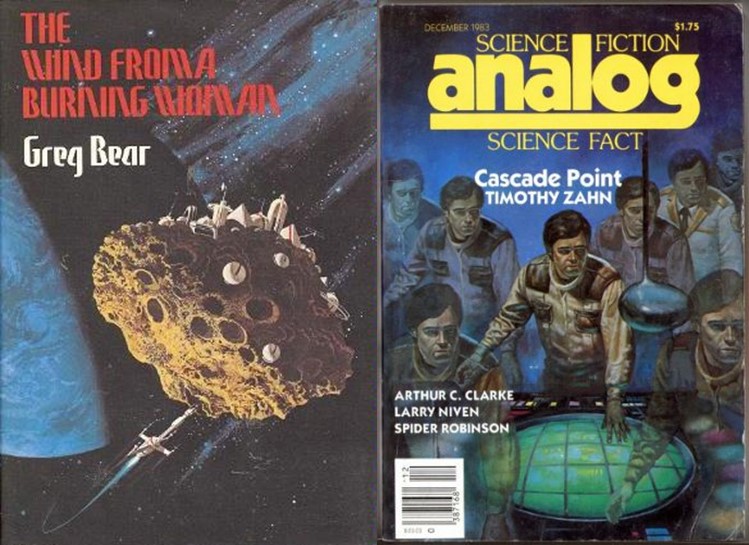 The Wind from a Burning Woman cover by Vincent di Fate
The Wind from a Burning Woman cover by Vincent di FateAnalog cover by Doug Beekman
Hardfought was originally published in Isaac Asimov’s Science Fiction Magazine in February, 1983. It was nominated for the Hugo Award and Nebula Award, winning the latter. It placed fifth in the Locus poll and second in the Science Fiction Chronicle Readers Poll.
John W. Campbell, Jr. was quoted as asking his writers to “Write me a creature that thinks as well as a man or better than a man, but not like a man.” In Hardfought, Greg Bear not only responds to Campbell’s challenge with the creation of the Senexi, an ancient star-faring race, but also with the creation of humans, who bear little resemblance to our own race. Layering these two creations under a lexicon which Bear does not offer to define, but the reader must learn from context, Hardfought provides a hard science fiction story which rewards the careful reader and is likely to leave the casual reader perplexed.
Bear flips back and forth between two protagonists in the story, the Senexi Aryz and a human Prufrax, although it isn’t entirely clear she is human except that Bear has applied that name to her. Her way of thinking and acting certainly feels as alien as anything Bear describes for Aryz. It is clear that the two cultures are at war with each other, but the details of the war, as well as Aryz and Prufrax’s roles in the battle are esoteric.
As with much science fiction, the patient reader is rewarded. It becomes clear that part of the reason for the war is that although the two races are different enough that they should be fighting over the same pieces of real estate, one of the issues is that they come from very different periods in the universe’s evolution. The Senexi are an ancient race, dating to practically moments after the creation of the universe. The Humans are a later race, evolving billions of years after the Senexi. The battle between the two sides is (partly) a generational issue. But even that is too simple an explanation for what is happening between the races.
In addition to the reasons for the war, Bear explores the psychology of the two races. The Senexi have a sort of brood mind with the soldiers like Aryz filling the role of a “branch ind,” clearly based on, but not entirely analogous to the society of bees on earth. The branch inds view themselves as completely expendable, but at the same time they take pride in their roles and seek to serve the brood as successfully as possible.
The humans, as seen by Prufrax, are not the individuals that we usually associate with humans and she seems to be almost a construct who is regenerated to fight as needed, her memories flashing back throughout the story. It is only slowly that her true situation comes to light and causes the reader to reëvaluate the entire story.
Bear is known as a writer of hard science fiction, and Hardfought certainly falls into that category, but it is also reminiscent of the sort of mind-bending concepts that can be found in the works of Samuel R. Delany or Gene Wolfe. Like those authors, and more than other works by Bear, Hardfought is a story which takes on deeper meaning the more time the reader gives to it, both in the reading and in the thinking about it.
While Bear (and other hard science fiction authors) often invents new science to allow himself to explore the worlds he has created, in Hardfought, Bear creates new civilizations and vocabulary, and trusts the reader to be able to figure everything out from context rather than attempting to explain what he is doing and what is happening.
The two hard science fiction stories in this volume of the Tor Doubles series both come from the same tradition, but they arrive in very different places. Zahn’s story is more traditional, and offers the reader its own twists and turns, while Bear’s tale is a much more complex and challenging exploration of the ethics of warfare and civilization.
 Steven H Silver is a twenty-time Hugo Award nominee and was the publisher of the Hugo-nominated fanzine Argentus as well as the editor and publisher of ISFiC Press for eight years. He has also edited books for DAW, NESFA Press, and ZNB. His most recent anthology is Alternate Peace and his novel After Hastings was published in 2020. Steven has chaired the first Midwest Construction, Windycon three times, and the SFWA Nebula Conference numerous times. He was programming chair for Chicon 2000 and Vice Chair of Chicon 7.
Steven H Silver is a twenty-time Hugo Award nominee and was the publisher of the Hugo-nominated fanzine Argentus as well as the editor and publisher of ISFiC Press for eight years. He has also edited books for DAW, NESFA Press, and ZNB. His most recent anthology is Alternate Peace and his novel After Hastings was published in 2020. Steven has chaired the first Midwest Construction, Windycon three times, and the SFWA Nebula Conference numerous times. He was programming chair for Chicon 2000 and Vice Chair of Chicon 7.
Comment on Easter Update by Bill
Thanks for the update and glad to hear that Book#4 is well under way, even if progress isn’t as fast as you’d like.
Looking forward to Essentia Capacity and if age or training can increase it for Stephen, even if only by a little…
Will the November release date for Book#3 be better for sales as you might be inside the Christmas timeframe as people struggle of gift ideas, or are sales fairly even during the year?
Book Review: Senseless by Ronald Malfi
I received a review copy from the publisher. This does not affect the contents of my review and all opinions are my own.
Mogsy’s Rating: 3.5 of 5 stars
Genre: Horror, Thriller
Series: Stand Alone
Publisher: Titan Books (April 15, 2025)
Length: 432 pages
Author Information: Website
Ronald Malfi is currently one of my favorite authors and I’ve greatly enjoyed all of his recent releases. However, Senseless was a bit of a mixed bag. While it delivers many of the things I’ve come to expect from Malfi, like an eerie atmosphere with just the hint of the supernatural, this particular story just didn’t resonate with me quite as strongly.
The novel opens with the grisly discovery of a woman’s mutilated body in the Mojave Desert, not far from the outskirts of Los Angeles. Detective Bill Renney is called to the scene to examine the remains and is unsettled to find eerie similarities to the case of another murdered woman that he’d worked on a year before. In fact, there’s enough to suspect that both women might have been killed by the same person—except that unbeknownst to anyone, Renney actually has secret information about these cases that might complicate his investigation.
Meanwhile, in a glitzier part of the city, author Maureen Park is celebrating her whirlwind engagement to powerful Hollywood producer Greg Dawson when the party is crashed by his son Landon. The twenty-something young man has lived a troubled life of aimlessness and addiction, but Greg’s latest attempt to keep his son out of the spotlight by sending him to school in Europe appears to have failed yet again. Already uncomfortable with Landon’s unpredictable behavior, Maureen is even more shocked and fearful after finding some disturbing items among his belongings.
And finally, we have a third POV character, Toby. The most mysterious of all, Toby drifts from place to place, fancying himself a “human fly” escaping from the “spider” and her web at home. Then one night at a club, he encounters an enigmatic woman who claims to be a vampire, sending him spiraling further into delusion as a powerful obsession for her takes over.
Senseless is the fifth book I’ve read by the author. By now I’ve come to associate his name with atmospheric horror and emotionally driven narratives, usually led by complex and flawed characters. This book largely delivers on all these counts. On the surface, it reads like a murder mystery and almost like a police procedural, especially when we are following Renney. He was my favorite character in the book, if nothing else for his part in the plot, which felt the most grounded and compelling, giving off that gritty, noir-like quality I appreciated. In a way, his chapters were also a deep character study of the man over the course of a year, starting from the unsolved murder of the first woman, when Renney was still mourning the recent death of his wife. With the discovery of the second murder victim a year later, his guilt and grief come roaring back, joining his growing suspicions to unravel what little peace he’s managed to hold onto.
In contrast, I was not so keen on Maureen or Toby’s chapters. To be sure, this book wasn’t without its hiccups, but admittedly it could have had something to do with my own struggles with abstract themes. At times, Toby’s POV even veered into surreal territory, a truly unreliable narrator if I’ve ever seen one. Worse, his rambling, fever dream-like chapters were often to the detriment of the story’s momentum, and every time I got one of his chapters, I had the urge to skim. Maureen’s storyline fared a little better, but I found that, while initially promising, her chapters tended to get lost in the shuffle. Granted, that’s also probably because the connections between the three characters were tenuous for most of the novel and demand a fair bit of patience from the reader. While answers do eventually come in time, I wonder if perhaps Malfi may have overreached a bit in making this one so structurally ambitious.
But my one real gripe lies with the ending. The final moments felt too abrupt, too unsatisfying. Sure, I can appreciate a story that leaves room for interpretation, but the resolution to Senseless, if you can even call it that, felt too ambiguous in leaving too many questions unanswered. Is it a dealbreaker? No. But I just wish we’d gotten a little more clarity.
At the end of the day, there’s a lot to admire here, and the greatest strength of Senseless lies in how Ronald Malfi managed to tie the threads of three disparate narratives together. However, this was not one of my favorites of his books. There were moments of brilliance, where his talent for crafting striking imagery and rendering realistically imperfect human characters really shines, but when we zoom out to look at the bigger picture, the hits don’t always land as cleanly as they aim for. As a fan of Malfi’s work, I’m still glad I read this, but for newcomers, there are probably more solid choices for an introduction to his horror and thriller fiction, like Come With Me or Black Mouth.
![]()
![]()
Fantastic, August 1961: A Retro-Review
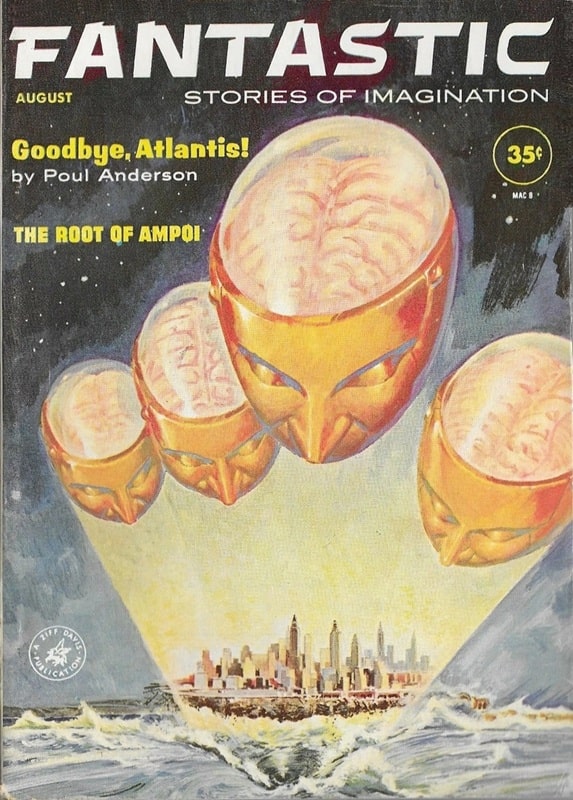
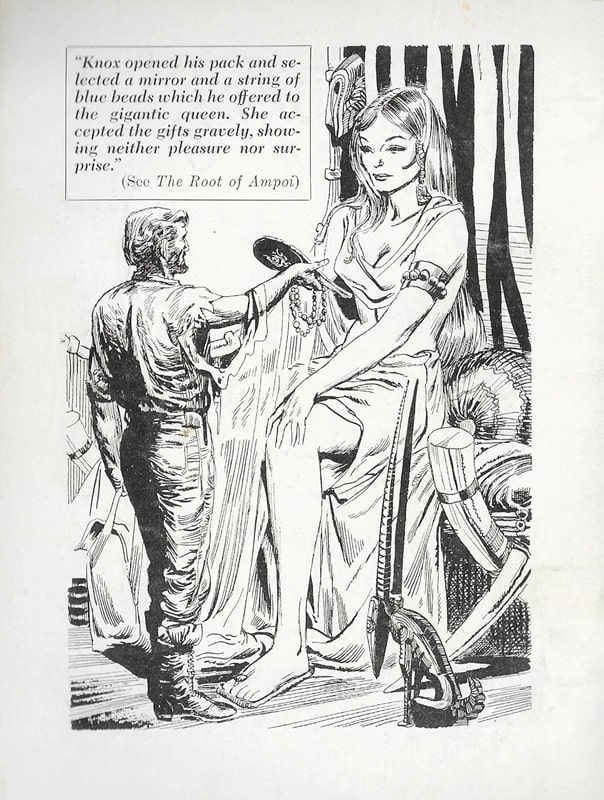
Fantastic, August 1961. Cover by Leo Summers
It’s been a long time since I did a Retro-Review from Cele Goldsmith’s time at Amazing/Fantastic. So I’m happy to be back at it! This issue is from about two years into Goldsmith’s tenure.
There are two features — Norman Lobsenz’s editorial, and the letter column, According to You. (Well, and a brief Coming Soon piece.) The editorial talks about using computers to analyze the various items certain Thais believe have magical powers, ending with a slight joke about hoping to find a love philtre “for Cele.” It introduces the concept by talking about the famous Arthur C. Clarke story in which a computer helps Tibetan monks list all the names of god — but misidentifies the story weirdly by adding another billion names: “The Ten Billion Names of God.”
[Click the images for fantastic versions.]
 Table of Contents for Fantastic, August 1961
Table of Contents for Fantastic, August 1961
According to You has six letters. I recognized some well-known fans: Bill Bowers and Redd Boggs were both prolific fanzine editors and multiple Hugo nominees. Lawrence Crilly, John Pocsik, and David Charles Paskow are not as was well known but do get mentions in Fancyclopedia 3, and indeed the Paskow Collection at Temple University is named for David Paskow. F. C. MacKnight is the other contributor.
The letters concern mostly Fritz Leiber and the newly instituted use of one reprint per issue — both get praise. David Bunch is of course mentioned — negatively by Bowers and positively by Paskow (the latter mention getting this relieved comment from Goldsmith: “We figured that if we kept publishing [Bunch], somebody sooner or later would agree with us that he has something in his stories.”)
The cover is by Leo Summers, the interiors are by Summers, Virgil Finlay, West, Dan Adkins, and Larry Ivie, with a Summers back cover based on the Smith story, and one cartoon by Frosty.
The stories, then.
Novelets“Goodbye, Atlantis!,” by Poul Anderson (9,000 words)
“Stranger in Paradox,” by Keith Laumer (9,200 words)
“Passage to Malish,” by Theodore L. Thomas (9,000 words)
“The Root of Ampoi,” by Clark Ashton Smith (5,900 words)
“One Small Drawback,” by Jack Sharkey (3,800 words)
“Report on the Magic Shop,” by Arthur Porges (3,000 words)
“Policeman’s Lot,” by Henry Slesar (3,600 words)
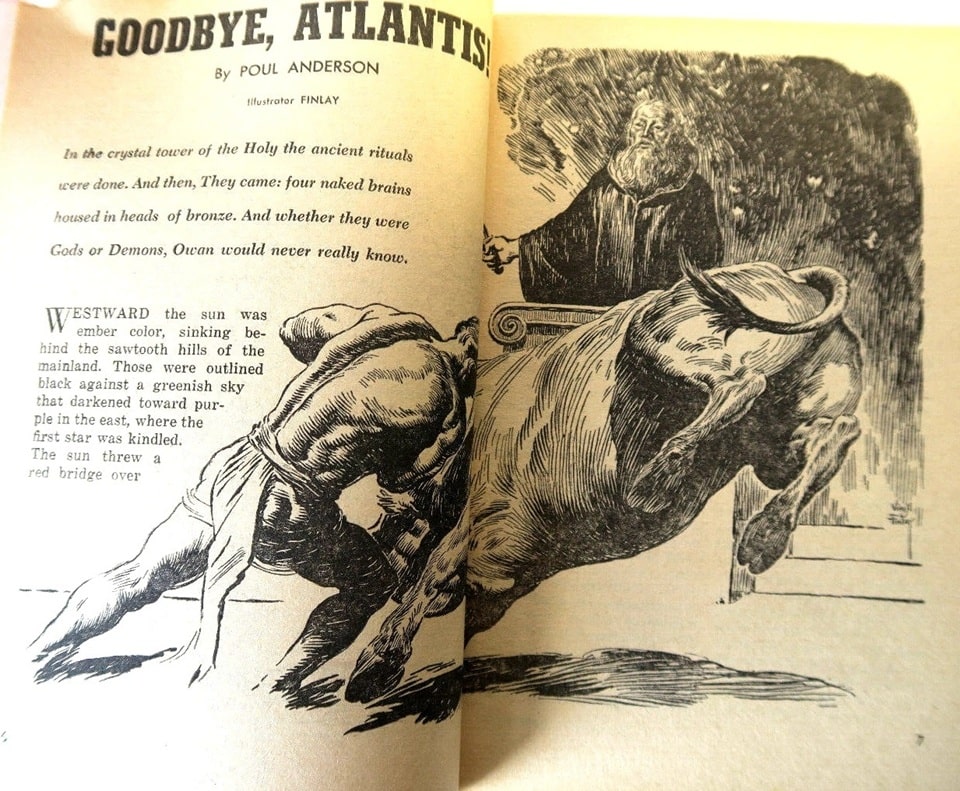 “Goodbye, Atlantis!” by Poul Anderson, illustrated by Virgil Finlay
“Goodbye, Atlantis!” by Poul Anderson, illustrated by Virgil Finlay
“Goodbye, Atlantis!” is a very obscure Anderson story — it’s only ever been reprinted once, in one of Sol Cohen’s super cheap and ugly all-reprint magazines, which mostly or entirely mined the Amazing/Fantastic backlist for material (and reprinted it (legally) without pay until SFWA objected, after which apparently Cohen made nominal payments.)
The lack of reprints is a bit odd, because “Goodbye, Atlantis!” isn’t terrible. It’s no lost classic, but it’s fine. The viewpoint character is Owan, a guard Captain in the retinue of the nobleman Donwirel and his wife Rianna, who is the niece of the former king of Atlantis, and thus cousin to the current king. Owan is in love with the beautiful Rianna, but at this time the concern is that there is a rebellion against the new king.
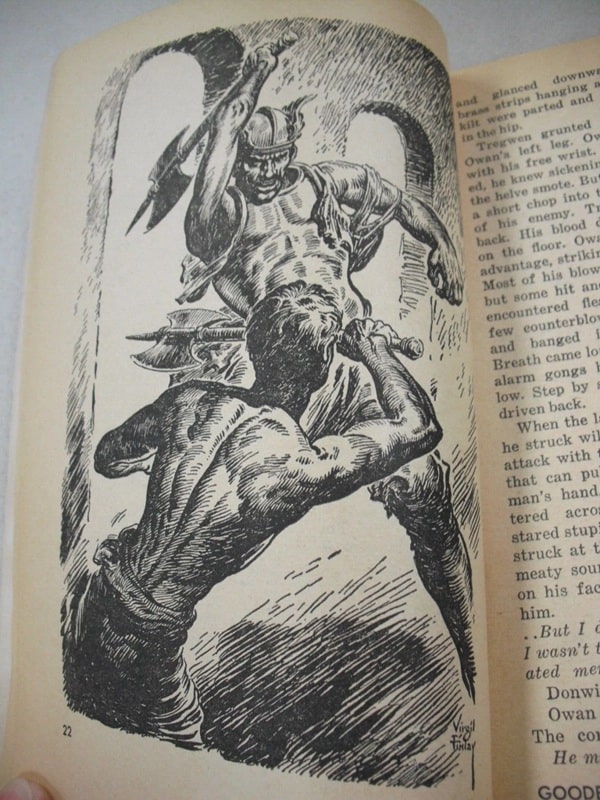 ‘Goodbye, Atlantis!” Illustration by Finlay
‘Goodbye, Atlantis!” Illustration by Finlay
The plot turns on the efforts of the Archpriest Govandon to summon the long absent gods of Atlantis to vanquish the rebels, who are clearly winning the war and have the capitol under siege. Owan has concerns — he doesn’t trust the gods, or perhaps simply doesn’t trust that Govandon’s spells will work. He goes to attend Donwirel, who is working with Govandon — and is poisoned.
It’s clear that Donwirel is a traitor, and only Rianna’s timely intervention saves Owan, after which he struggles to prevent Donwirel from stealing the spells Govandon has learned. There’s some solid action, and Owan (and Rianna) are successful — but their success proves profoundly ambiguous. (Behind it all is a sly suggestion that the rebels were right all along.)
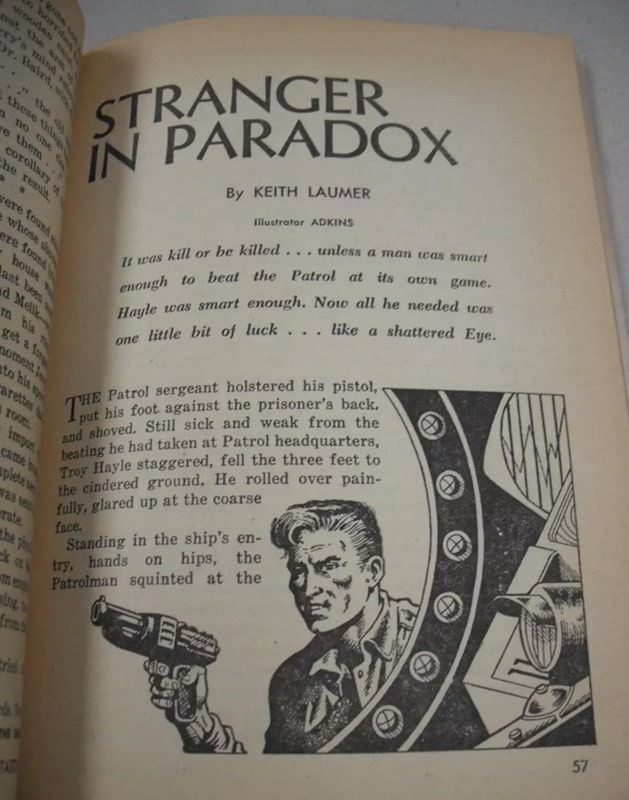 “Stranger in Paradox” by Keith Laumer. Illustrated by Dan Adkins
“Stranger in Paradox” by Keith Laumer. Illustrated by Dan Adkins
“Stranger in Paradox” was, I think, Keith Laumer’s fourth published story. The first two, “Greylorn” and “Diplomat-at-Arms” were published by Goldsmith as well — Laumer was one of her major discoveries, along with Le Guin, Disch, Zelazny and to some extent Ballard (for the American market.) The Retief stories (after “Diplomat-at-Arms”) ended up finding a home in Frederik Pohl’s If, but Goldsmith otherwise published a great deal of Laumer’s early work.
Alas, “Stranger in Paradox” is pretty awful. Hayle is dumped on the title planet by the Patrol, who seem to be the agents of the despotic rulers of this future. (Details are pretty slight.) They leave him nothing but a short sword and a reusable match. The only rule on Paradox is that prisoners cannot cooperate — they must either avoid each other or fight.
Hayle’s plan is to somehow convince a couple of other people to cooperate, and after figuring out how the Patrol keeps track of the prisoners, he manages that … and then, with a profoundly implausible plot, lots of luck, a woman prisoner falling into their laps, and utterly ridiculous concept of both how the Patrol would work and how they control civilization, they succeed. It’s just dumb dumb dumb the whole way, redeemed only slightly by the fight scenes that are, as usual, quite good — Laumer had the knack of writing fights.
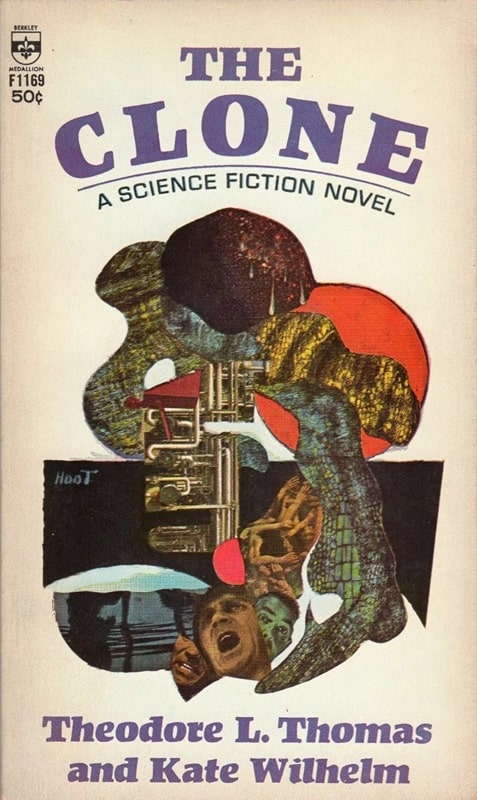
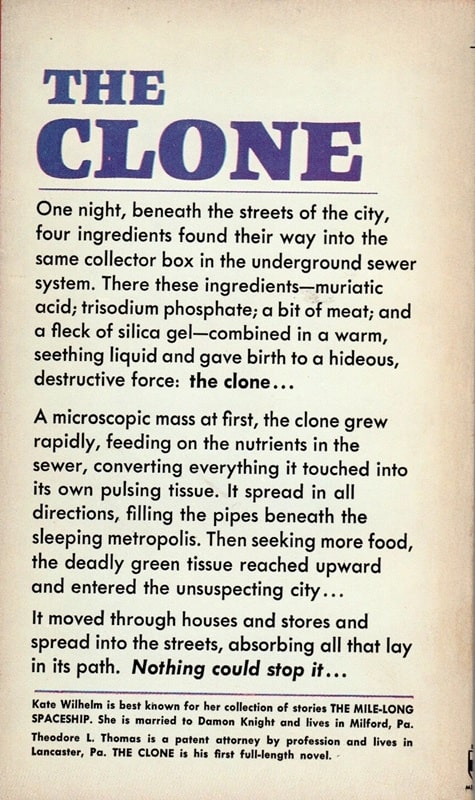
The Clone by Theodore L. Thomas and Kate Wilhelm
(Berkley Medallion, December 1965). Cover by Hoot von Zitzewitz
Theodore L. Thomas (1920-2005) was a chemical engineer and patent attorney who wrote about 50 short stories between 1952 and 1981. He wrote two novels in collaboration with Kate Wilhelm (The Clone and The Year of the Cloud.) He is probably best known still for a series of stories he wrote as “Leonard Lockhard” about science fictional complications with patents — the first two of these in collaboration with fellow patent attorney Charles Harness; and for his story “The Weather Man,” about human control of the weather.
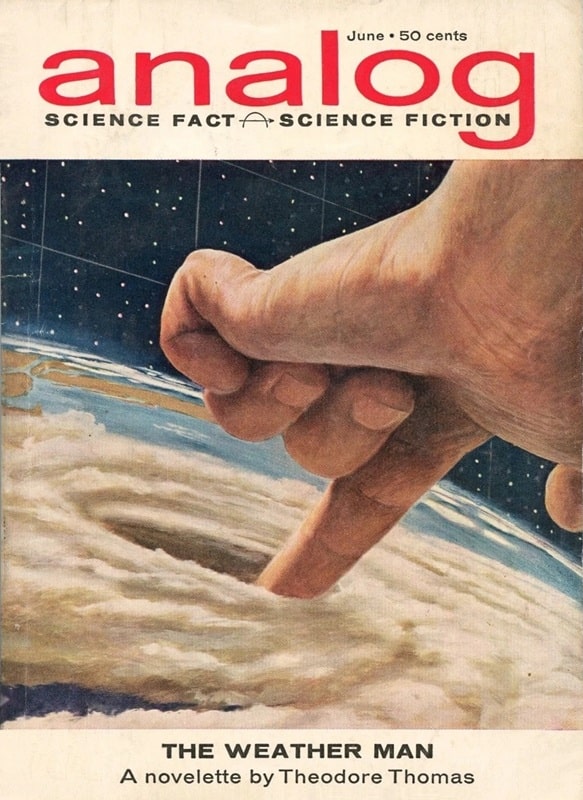 Analog Science Fact/Science Fiction June 1962, containing “The Weather Man” by Theodore L. Thomas. Cover by John Schoenherr
Analog Science Fact/Science Fiction June 1962, containing “The Weather Man” by Theodore L. Thomas. Cover by John Schoenherr
“Passage to Malish” is about a salesman who finds himself diverted from his trip to the planet Malish because it’s been determined that he’s the perfect person to confront the visiting aliens from the Large Magellanic Cloud. The solution involves turning him into a superhuman, committing genocide (or galactocide, I suppose), and then hoping he’ll consent to being turned back to a normal human before he uses his powers to subvert the Milky Way. I never believed any of this story for a second.
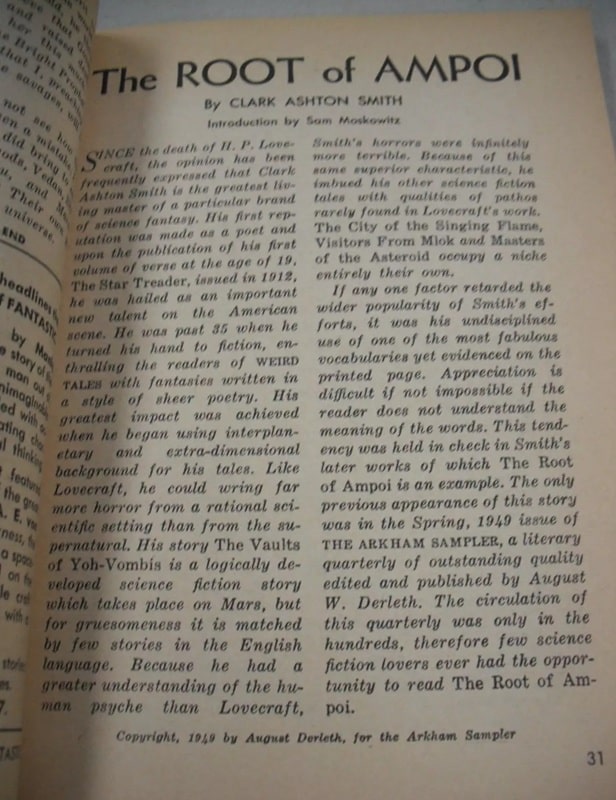
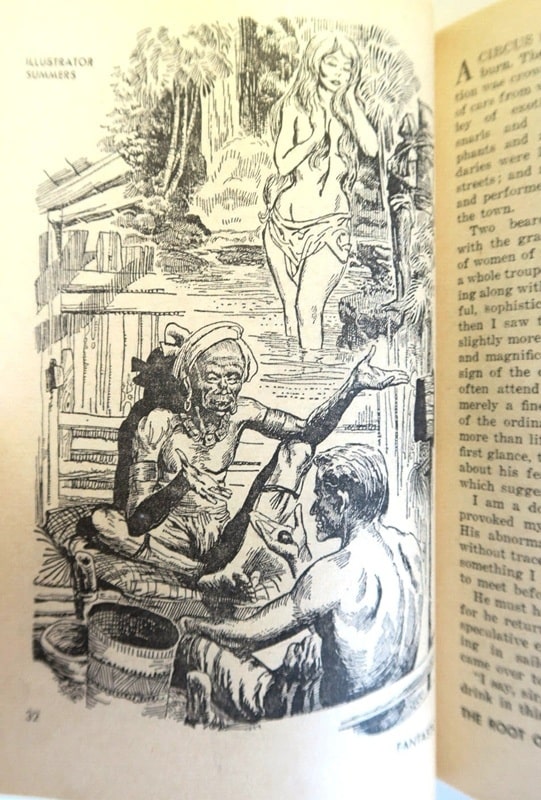
“The Root of Ampoi” by Clark Ashton Smith. Illustration by Summers
“The Root of Ampoi” is Sam Moskowitz’s choice for this month’s fantasy reprint. Clark Ashton Smith (1893-1961) was a poet and a writer of weird fiction whose reputation has gone up and down over time, and seems on the upside now. He was a regular contributor to Weird Tales, and part of Lovecraft’s circle. He was known for his ornate prose and extravagant imagination, so, Moskowitz, with his impeccable as ever taste, declaring in more or less Salieri mode that Smith used “too many words” (that’s my paraphrase of Moskowitz’ words) chose a completely uncharacteristic story to reprint. (That said, it has been reprinted fairly often, one time as “The Ampoi Giant,” so other people may disagree with me.)
“The Root of Ampoi” is a tale told by a giant working for a circus. He was a sailor, and he heard of a place on New Guinea where the men were normal sized and the women were nine feet tall. And there were rubies to be had for a song. Seeking to make his fortune, he finds this place, and learns about the secret that makes the women so tall — after the queen of those women chose him for a consort. But, unhappy with being dominated by a much larger wife, he ferrets out the secret… the punishment for which is banishment. No rubies either. But — easy to find circus work. This is really minor stuff — a competently executed tall tale, really. But it seems nothing like a real introduction to CAS.
Jack Sharkey (1931-1992) was a Cele Goldsmith regular, though to my taste he was a pretty weak writer. “One Small Drawback,” however, is not too bad at its length. Jerry, a college kid, is intrigued by his professor’s research into telekinesis, but nothing he tries has any effect. His professor is convinced that what he needs is true belief. Then something small happens that convinces Jerry he can use telekinesis… but it doesn’t work consistently. The key element he eventually discovers is pretty clever, and effectively dark.
Arthur Porges (1915-2006) wrote over 200 stories, split roughly 50/50 between mystery and SF. His stories were mostly fairly short, and were consistently clever, sometimes amusing, sometimes quite mordant. As a writer of exclusively short fiction, he’s not really widely remembered, but he was one of the most dependably enjoyable writers in the field, and his contributions appeared right up until his death, mostly in F&SF but also in Goldsmith’s magazines. “Report on the Magic Shop” is good solid fun, nothing earth-shattering, written as if the author is telling the editors about the various products sold at a magic shop he happened to stumble into.
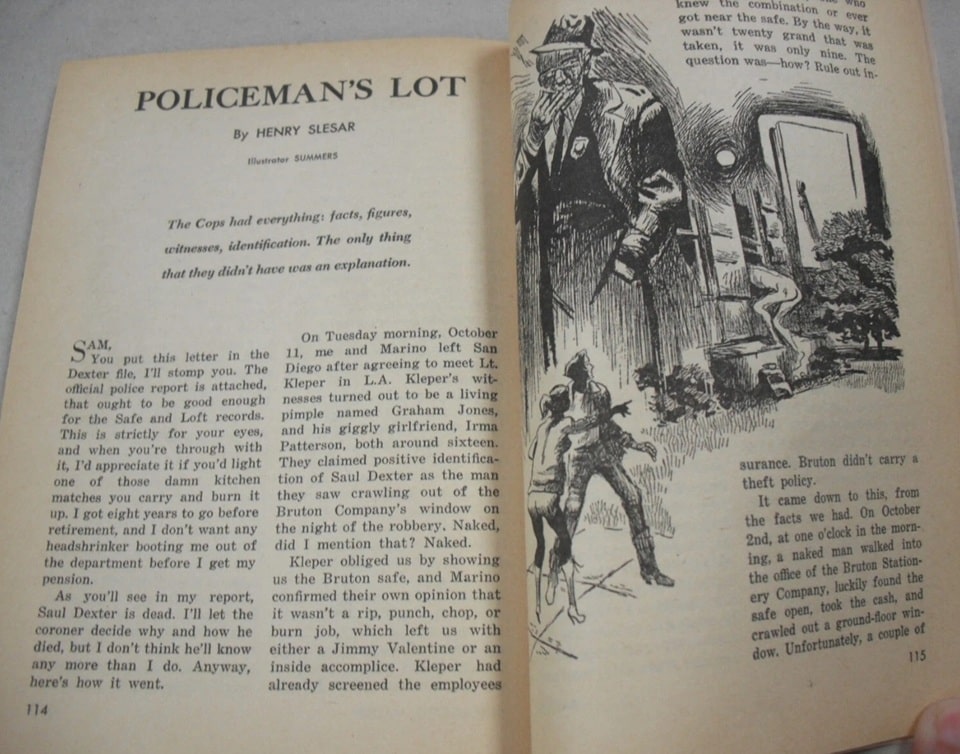 “Policeman’s Lot” by Henry Slesar. Illustration by Summers
“Policeman’s Lot” by Henry Slesar. Illustration by Summers
Henry Slesar (1927-2002) was another writer of both SF and crime fiction, with most of his SF fairly short. He was better known as a mystery writer, and so perhaps it isn’t a surprise that “Policeman’s Lot” is basically a mystery, though with a fantastical solution.
A veteran patrolman submits a report on a strange case he recently investigated, involving a couple of basically “locked room” thefts, in which in one case a man was found escaping from a window naked. Not long after, the man is found crushed to death in his house. The strange factor is that he seems to have changed height between separate arrests. The solution is kind of obvious, and acceptable except as an explanation of his death.
Rich Horton’s last article for us was We Are Missing Important Science Fiction Books. His website is Strange at Ecbatan. Rich has written over 200 articles for Black Gate, see them all here.
Women in SF&F Month: Sara Hashem
Today’s Women in SF&F Month guest is Sara Hashem! Her Egyptian-inspired epic fantasy debut novel, The Jasad Heir, was a Sunday Times bestseller and a Goodreads Choice Award nominee in the Romantasy category. Her next novel and the conclusion to her Scorched Throne duology, The Jasad Crown, will be released on July 15. I’m very excited for its release since her first novel was one of my favorite books of 2023 with its excellent banter and character dynamics, including an […]
The post Women in SF&F Month: Sara Hashem first appeared on Fantasy Cafe.Spotlight on “Measure of Devotion” by Nell Joslin
Measure of Devotion, Nell Joslin’s fantastic novel, is the sweeping grandeur of the mountains, the…
The post Spotlight on “Measure of Devotion” by Nell Joslin appeared first on LitStack.

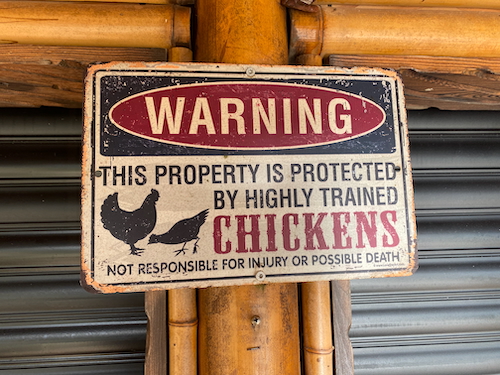
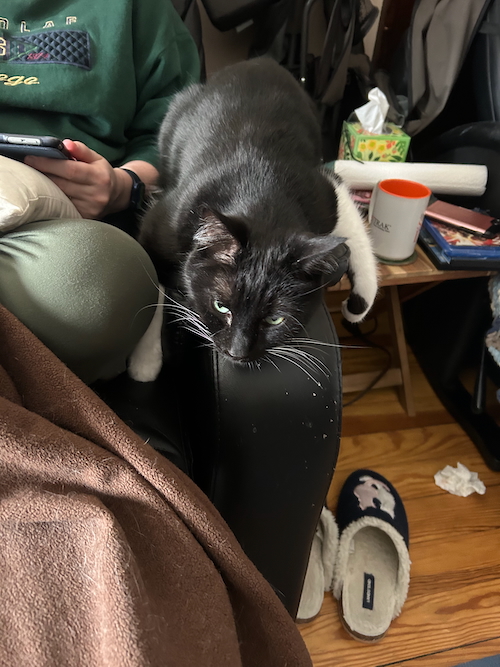
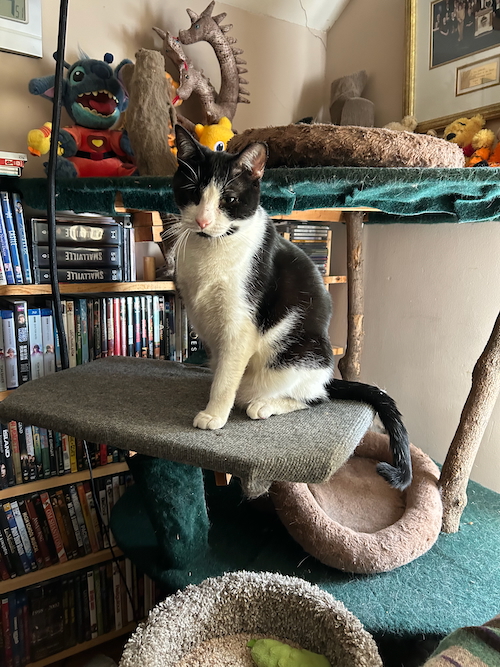


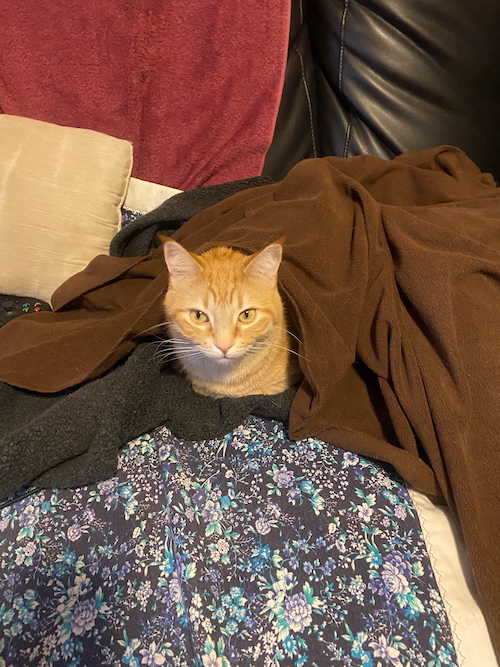
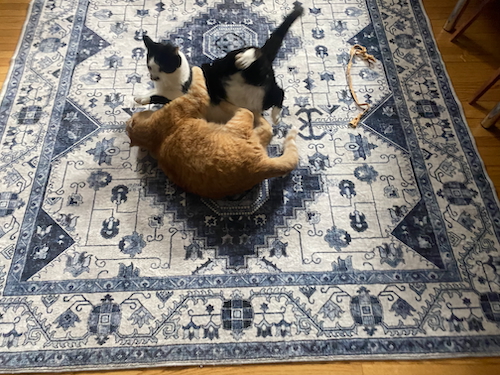




Recent comments